Q&A with
Why Bloomberg Philanthropies is investing in vibrant oceans
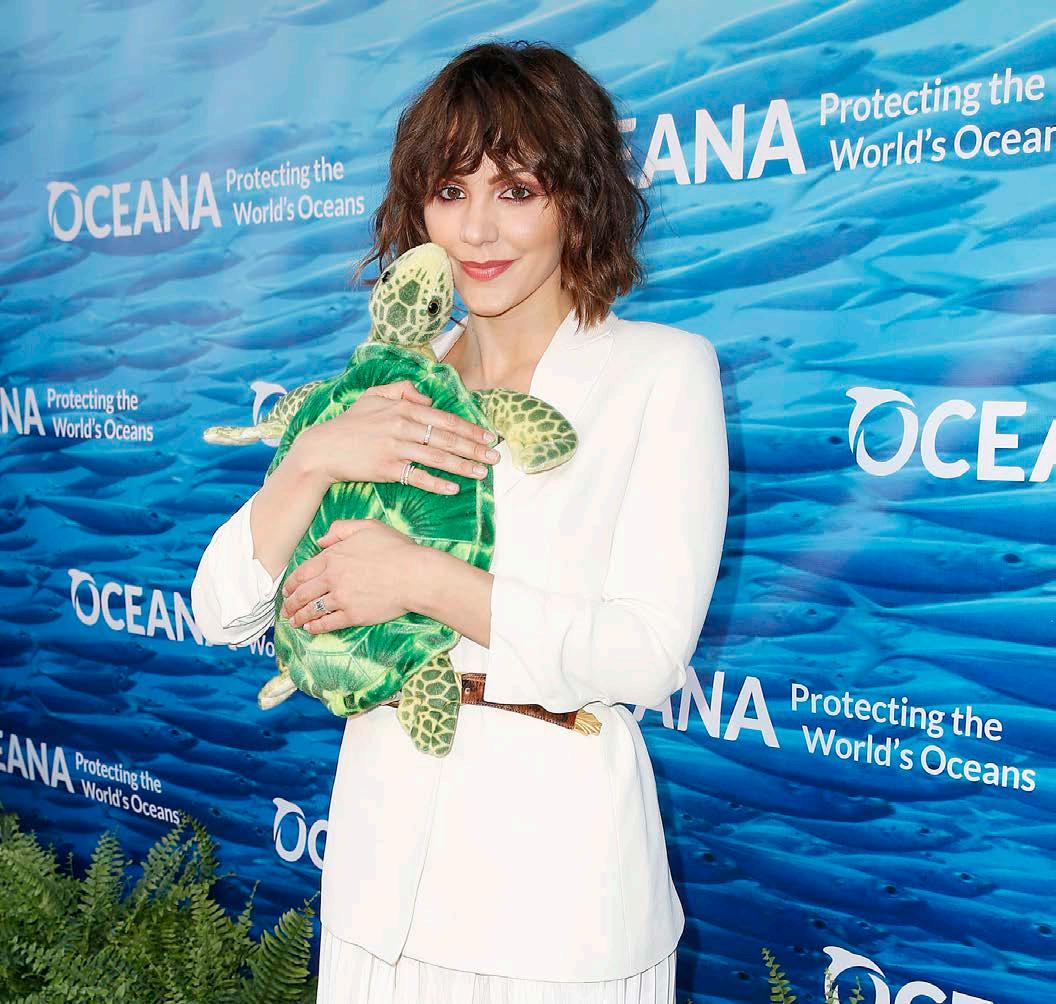
SUMMER 2018
The Tide Turns on Trawling
How Oceana protected 275,000 square miles of deep-sea habitats off the U.S. West Coast
Katharine McPhee helps to raise $1.3 million for Oceana at annual SeaChange gala
OCEANA.ORG
“Twilight Zone” Reefs Earn a Conservation Spotlight
In the Philippines and beyond, new protections for deep-dwelling tropical corals
Patti Harris
Magazine
©Tom Vickers
Board of Directors
Simon Sidamon-Eristoff, Chair
Valarie Van Cleave, Vice Chair
María Eugenia Girón, Treasurer
James Sandler, Secretary
Keith Addis, President
Gaz Alazraki
Monique Bär
Herbert M. Bedolfe, III
Ted Danson
Sydney Davis
César Gaviria
Loic Gouzer
Jena King
Sara Lowell
Stephen P. McAllister
Dr. Daniel Pauly
Dr. Kristian Parker
David Rockefeller, Jr.
Susan Rockefeller
Heather Stevens
Dr. Rashid Sumaila
Diana Thomson
Sam Waterston
Jean Weiss
Allison Guy Designer
Karen Radewald Contributing Writer Amy McDermott
Ocean Council
Susan Rockefeller, Chair
Kelly T. Hallman, Vice Chair
Dede McMahon, Vice Chair
Violaine Bernbach
Carolyn Marks Blackwood
Keely and Pierce Brosnan
Deborah Buck
Richard M. Burnes, Jr. Amy and Gary Churgin
Vin Cipolla
Barbara Cohn
Ann Colley
Andrew Davis
Sydney Davis
Michael Dershewitz
Edward Dolman
Barbara Ettinger and Sven Huseby
Lise Evans
Christina Falco and Michael Frumkin
Kay Fernandez
Joanna and Brian Fisher Kelsey Grammer
Carolyn Groobey
Marjorie Harris
Julie Hill
Carey Hotchkis
Hardy Jones
Angela and J. Stephen Kilcullen
Arlene and Robert Kogod
Slane Holland Lightburne
Ann Luskey
Willa and Ted Lutz
Tiffany Moller
Aaron Peirsol
Nicole Polizois
Perri and Mario Procida
Lori and John Reinsberg
David Rockefeller, Jr.
Anne Alexander Rowley
Eve Kornyei Ruffato
Andrew Sabin
Jennifer Small and Adam Wolfensohn
Danielle Steakley
Sutton Stracke
Julie Tauber McMahon
Mia Thompson
Dr. David Treadway
Susan Trees
Toby Usnik
Jennifer Schwab Wangers
David Max Williamson
Raoul Witteveen
Oceana is published by Oceana Inc. For questions or comments about Oceana, or to subscribe to Oceana, please call our membership department at +1.202.833.3900, e-mail membership@ oceana.org or write Oceana, Member Services, 1025 Connecticut Ave. NW, Suite 200 Washington, DC 20036 USA
Oceana Staff
Chief Executive Officer
Andrew Sharpless President Jim Simon
Chief Scientist & Strategy Officer
Michael Hirshfield, Ph.D.
Chief Policy Officer, North America Jacqueline Savitz
Senior Vice President & Executive Director, Europe Lasse Gustavsson
Senior Vice President, Strategic Marketing & Communications Matthew Littlejohn
Vice President, Belize Janelle Chanona
Executive Director, Oceana Canada Joshua Laughren
Vice President, Peru Patricia Majluf, Ph.D.
Vice President, Chile Liesbeth van der Meer
Vice President, Philippines Gloria Estenzo Ramos, J.D. Vice President, Brazil Ademilson Zamboni, Ph.D. Vice President, Development Nancy Golden
Chief Financial Officer Christopher Sharkey Chief of Staff Leslie Jones
Deputy Vice President, U.S. Pacific Susan Murray
Oceana’s Privacy Policy: Your right to privacy is important to Oceana, and we are committed to maintaining your trust. Personal information (such as name, address, phone number, e-mail) includes data that you may have provided to us when making a donation or taking action as a Wavemaker on behalf of the oceans. This personal information is stored in a secure location. For our full privacy policy, please visit Oceana.org/privacypolicy.
2
Editorial Staff Editor
Please Recycle.
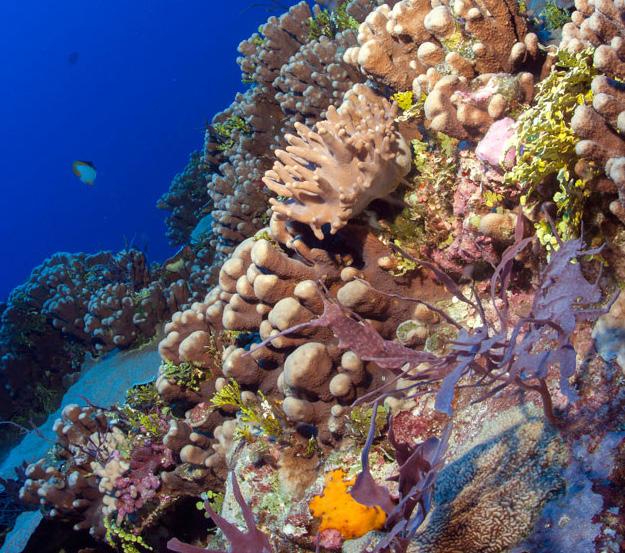

Features Departments To help you navigate Oceana’s work, we’re introducing icons for our five major campaigns. Look for them throughout the magazine to learn more about what Oceana focuses on. Curb Pollution Stop Overfishing Reduce Bycatch Protect Habitat Increase Transparency 275,000 square miles of U.S. West Coast habitat safeguarded 12 Protecting “twilight zone” coral reefs 18 CEO note In a sweltering summer, hope — and setbacks — for our oceans For the win Responsible regulations for Brazil’s mullet, Patagonian protections and more News & notes Why vessels “go dark” at sea, Europe’s plastic pollution problem and more Q&A Patti Harris on Bloomberg Philanthropies’ Vibrant Oceans Initiative The tide turns on trawling How Oceana protected 275,000 square miles of deep-sea habitat Deep reefs rising “Twilight zone” reefs are bigger and more vital than ever expected Oceana victories A timeline of success Supporter spotlight Jim and Susan Rothwell, and Kira Cahill and Olivia Dahan Ask Dr. Pauly What are stock assessments? Events SeaChange and Rock Under the Stars Fin win Mackerel makes a comeback Parting shot Belize’s barrier reef delisted from World Heritage in Danger 5 / 6 / 8 / 10/ 12/ 18/ 27/ 28/ 30/ 32/ 36/ 38/
Please Give Generously Today
Your contribution will help ensure our oceans are vibrant and sustainable. Help us save the oceans and feed the world.
Call us today at (202) 833-3900, email us at info@oceana.org, visit www.oceana.org/give or use the envelope provided in this magazine to make a donation. Oceana is a tax-exempt 501(c)3 organization and contributions are taxdeductible to the fullest extent of the law.

Your support would be fin-tastic.
©Ethan Daniels/Shutterstock 4
Recently, when I was speaking about how Oceana’s policy wins will make the oceans more abundant and able to feed a growing population, someone asked what protecting “Carl” had to do with that. Momentarily confused, I realized that my Philadelphia roots had revealed themselves in my pronunciation of the word for the small animal that builds reefs.
Coral reefs are dying around the world. In 2016 and 2017, underwater heat waves killed off one-third of Australia’s Great Barrier Reef — a decline so abrupt it left scientists stunned. Reefs are threatened by warmer oceans, overfishing, pollution and changes in ocean chemistry that make seawater more acidic.
The second-largest reef in the world is the Mesoamerican Reef, located off the coasts of Belize, Mexico and Honduras. Belize’s portion of the reef is home to seven UNESCO World Heritage sites, including the famous Great Blue Hole, a collapsed submarine cave. The United Nations declared this network of marine reserves endangered in 2009.
By itself, Belize cannot protect its reef from every threat it faces. Hotter and acidifying oceans are a result of rising atmospheric CO2, released worldwide by unmanaged burning of fossil fuels.

These temperature changes have been dramatic this summer. Here are just a few of the records that had been set as of late July:
• On July 23, Japan recorded its highest temperature ever: 41 C (106 F)
• Ouargla, Algeria, reached 51 C (124 F) on July 5, Africa’s highest-ever confirmed temperature
• On June 28, Quriyat, Oman, set the world record for the hottest nighttime low: 43 C (109 F)
• Amsterdam and Rotterdam recorded their hottest temperatures ever on July 30, 35 C (95 F) and 97 F (36 C), respectively
• The Swedish village of Kvikkjokk, north of the Arctic Circle, hit an all-time high of 33 C (91 F)
• Montreal sweltered under 37-degree (98-degree) heat on July 2, its warmest day on record
• Cities across Texas withered under all-time highs on July 24, with Waco hitting 46 C (114 F)
Forty percent of the Mesoamerican Reef is in Belizean waters. Belize is proud of its reef, which is essential to the more than 30 percent of its economy that relies on tourism and fishing. To help protect this globally recognized resource, Belize banned bottom trawling in 2010 and all offshore oil drilling in 2017. The world noticed. In June, the United Nations formally upgraded the status of the Belize World Heritage Site. It is no longer endangered.
Oceana fought for the policy changes that will give the reef a chance to survive the coming decades. Belizean Prime Minister
Dean Barrow recognized our contribution in a formal ceremony thanking our leader, Janelle Chanona. “I pay full tribute to Oceana in Belize’s mobilization of citizens to persuade and to push Government to go further, I immediately concede, than perhaps might have been our original contemplation,” he said.
Unfortunately, the leaders of the United States — both President Trump and his allies in Congress — have not shown the same wisdom in protecting the American ocean. They are initiating formal procedures to lease the entire east and west coasts to ocean oil drillers. And, at the very moment that climate change threatens to drive more and more species to the brink of extinction, they have introduced legislation to gut the Endangered Species Act.
The Eastern Pacific gray whale and the bald eagle are two creatures that are now out of danger thanks to the Endangered Species Act. This is a law that works. It protects life. And we need it now more than ever.
Republican leaders in Congress argue that the law’s longstanding protections against extinction unreasonably restrict economic development. Yet the U.S. is now at virtual full employment, and the stock market regularly breaches its all-time highs.
Facts and science are the essence of good policy. Belizean leaders have demonstrated how that gets done. Sadly, American leaders are demonstrating the reverse.

For the oceans,
Andrew Sharpless CEO, Oceana

SUMMER 2018 | Oceana.org5
Note
©Wollertz/Shutterstock
For The Win
Tainha, a fish vital for food and income in southern Brazil, gains its first-ever catch quota
If you ever chow down on tainha na taquara — mullet roasted in bamboo — you might have a dolphin to thank. In Santa Catarina, a state in the south of Brazil, bottlenose dolphins and fishermen cooperate to corral and catch mullet. The big-brained bottlenoses get their pick of fish escaping the nets, and the fishermen land more than they would on their own.
There’s a new partnership in Santa Catarina, one that’s perhaps just as unusual. In May, artisanal and commercial fishermen, scientists and government officials — groups that often struggle to see eye-to-eye — agreed to implement a catch quota for mullet, the first for any fish in Brazil in 10 years.
Oceanographer Ademilson Zamboni, the head of Oceana’s Brazil team, called the development a “milestone.” No other fishery in Brazil currently benefits from meaningful management efforts, he said. Zamboni hopes that these mullet, locally known as tainha, can serve as an example for the rest of the country.
For the last three years, Oceana has campaigned for evidence-based management of tainha, a key source of food and income along Brazil’s southern coast. In 2017, Oceana partnered with fishermen to launch the online Tainhometro, or Mullet Meter, to track the mullet catch in near-real time. Fishermen self-reported their catch to the website, helping Oceana make the case that scientific management was not only desirable, but feasible. In 2018, the Tainhometro became an official channel showing the total landings for the entire fishing season.
Smart tainha management is good news for fishermen, and for Santa Catarina’s dolphins too.
U.S.
Vast marine habitats off U.S. West Coast now offlimits to destructive fishing
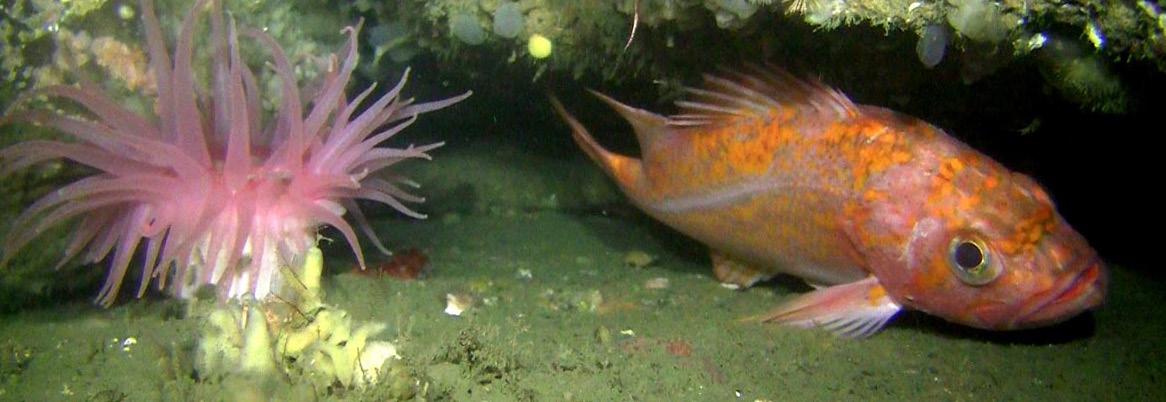
In April, the Pacific Fishery Management Council unanimously voted to protect more than 363,000 square kilometers (140,000 square miles) of seafloor habitats off California, Oregon and Washington. With this decision, more than 90 percent of West Coast state and federal waters will be protected from bottom trawls — weighted fishing nets that can topple and crush deep-sea corals and sponges. This decision, the result of campaigning by Oceana, fishermen and other allies, will protect key habitat for wildlife and scores of commercial fish species, including dozens of species of rockfish. “The Council’s action will ensure these spectacular seafloor habitats can continue to sustain healthy fisheries and support other ocean creatures into the future,” said Susan Murray, Oceana’s deputy vice president for the Pacific. For more about this victory, turn to page 12.
Benham Bank, part of a submarine plateau off the northeast Philippines, is blanketed in tropical corals adapted to living in deep, low-light conditions.
In March, the Philippine government protected 500 square kilometers (200 square miles) of Benham Bank’s pristine reefs from all human activities except research — a bold decision, given the complex politics with China over maritime actions in the region. A further 3,000 square kilometers (1,150 square miles) were set aside as a special zone where fishing with active gear is prohibited.
6
Pristine “twilight zone” reefs protected in the Philippines
Canary rockfish will benefit from new
West Coast habitat protections.
©Oceana
The declaration was the result of an extensive Oceana campaign that partnered with allies in the government, private sector and civil society. The campaign began in 2016, when Oceana joined government scientists on an expedition that documented reefs with up to 100 percent coral cover. For more about this victory, turn to page 18.
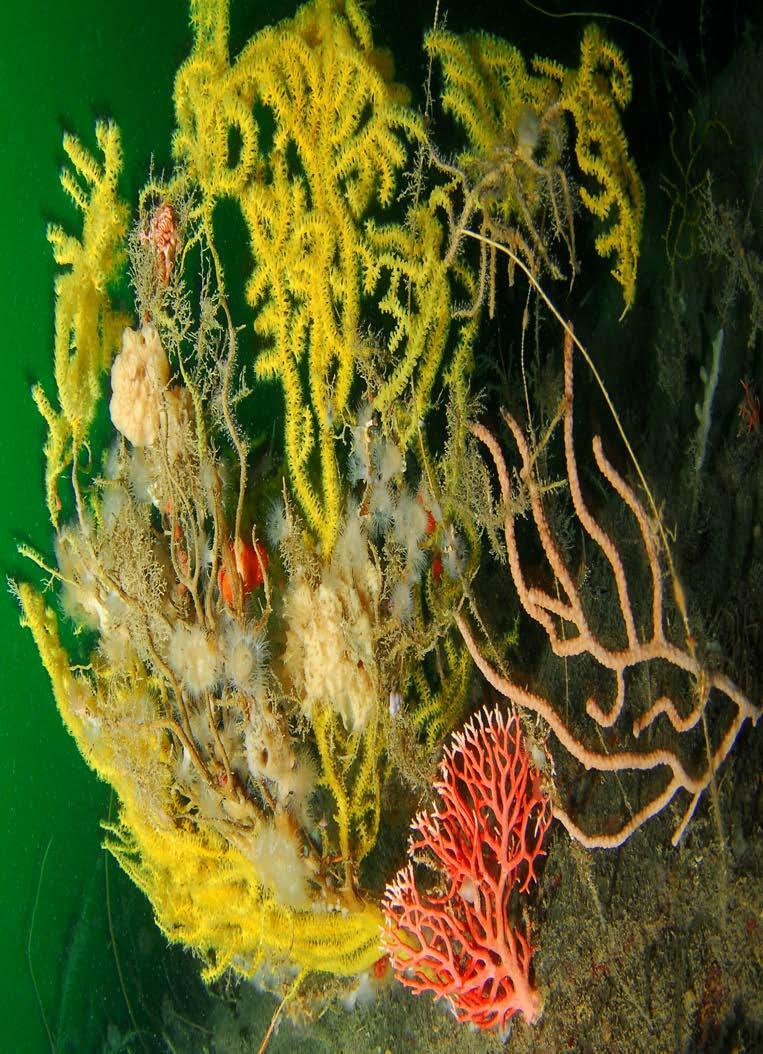
Unique Patagonian seascape declared a protected area
The tiny community of Caleta Tortel, known for having wooden walkways in place of roads, is nestled amid fjords, mountains and glacier-fed rivers in the south of Chile.
In late February, the Chilean government created a 6,700-square-kilometer (2,600-square-mile) protected area divided between the region’s ocean and inland channels. For 10 years, Oceana, Tortel residents and government officials have fought to protect the community and its surroundings from industrial salmon farms and other threats. The February decision safeguards not only an area of exceptional beauty, but biodiversity as well. The new protected area is home to vulnerable sponge and coral habitats, as well as endemic species like the Chilean dolphin.
SUMMER 2018 | Oceana.org7
Tortel’s seafloor habitats are now permanently protected from industrial salmon farming.
©Oceana
News + Notes
Fishing vessels appear to “go dark,” raising concerns about possible illegal activity
The Wild West days of fishing are numbered. Satellite tracking technology and powerful algorithms that analyze vessel movements mean it’s becoming harder for fishing boats to keep illegal activity out of sight.
Case in point: Oceana used the vessel tracking platform Global Fishing Watch — co-developed and funded by Oceana, Google and SkyTruth two years ago — to identify four commercial fishing vessels that appeared to “go dark,” possibly turning off their public tracking systems suspiciously close to areas off-limits to fishing, or near the national waters of developing countries.
One Panamanian ship appeared to switch off its automatic identification system, or AIS, at the west side of the Galápagos Marine Reserve, a protected area known for its abundance of fish and sharks, where industrial fishing is prohibited. Fifteen days later, its AIS track reappeared on the park’s opposite border. And, over the course of a year and a half, a Spanish vessel appeared to go dark repeatedly as it approached the national waters of The Gambia, a small, developing country in West Africa.
AIS was initially developed to help ships avoid collisions. Vessels that deliberately turn it off could be hiding a host of criminal activities, from illegal fishing to human trafficking.
“These vessels may have been deliberately hiding their tracks — but why would any vessel want to do that?” asked Beth Lowell, Oceana’s senior campaign director for illegal fishing and seafood fraud. “Fishing vessels should be required to broadcast AIS at all times, increasing transparency and accountability at sea.”
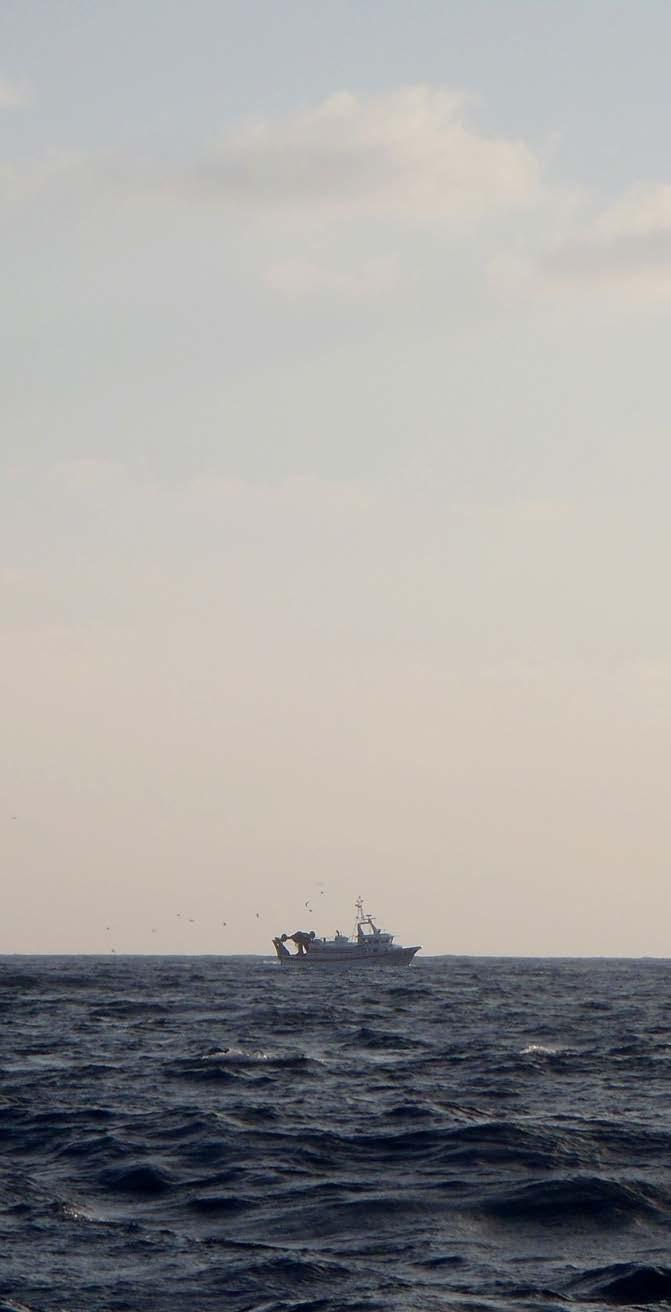
AIS was initially developed to help ships avoid collisions. Vessels that deliberately turn it off could be hiding a host of criminal activities, from illegal fishing to human trafficking.

8
© Oceana/Marta Carreras
The United States’ toughest sailing race is also its most sustainable
In June, a French-Italian team won the 2018 Atlantic Cup, a marathon offshore race from Charleston, South Carolina, north to Portland, Maine. Skipper Catherine Pourre was the first female victor in the cup’s history, but she wasn’t the only winner that day — the ocean also came out on top.
California
passes bill to protect wildlife from dangerous swordfish drift gillnets
In California, a type of fishing gear sometimes called “walls of death” could be reaching its final days. In late May, the California Senate voted to phase out largemesh drift gillnets used to target swordfish off the coast. These milelong nets, which snag swordfish by the gills, also indiscriminately catch sharks, other fish, sea turtles and marine mammals.
The bill, which would eliminate large-mesh drift gillnets by 2023, compensates fishermen for their nets and permits, and incentivizes them to switch to cleaner gear like deep-set buoys. Deep-set buoy gear lets fishermen reel up swordfish immediately — making the fish fresher and more valuable — while dramatically reducing the incidental catch and killing of other species.
Oceana documents widespread plastic pollution in Europe’s deep seas
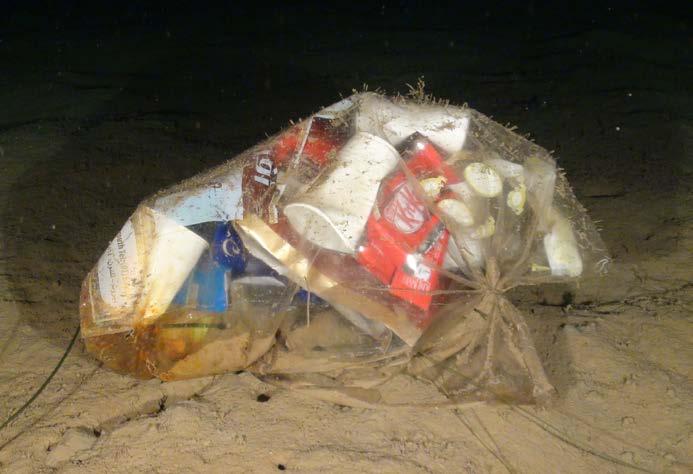
Europe’s deep waters are reservoirs for marine biodiversity — and lots and lots of plastic. Oceana’s expeditions across Europe have documented wrappers, bottles and other junk as deep as 1,000 meters (3,280 feet), including a balloon in the shape of Finding Nemo’s clownfish stars. For every piece of plastic floating on the surface, dozens more litter the deep sea, said Oceana senior research director Ricardo Aguilar.
To address its ocean plastic crisis, the European Union unveiled a plan in late May to ban a host of throwaway plastic items including plates, cutlery, drink stirrers, straws, cotton buds and balloon sticks. These six types of items, together with fishing gear, make up 70 percent of the plastic trash by count found on Europe’s beaches.
The Atlantic Cup is a Sailors for the Sea Platinum Level Clean Regatta. Each stopover of this carbon-neutral event featured ocean science activities for local students. In addition to the Clean Regattas program, Sailors for the Sea offers green guidelines for sailing and creates marine conservation curricula for young sailors. The organization, co-founded by Oceana board member David Rockefeller, Jr., joined Oceana this year.
Oceana launches campaign teams in Mexico and the UK
In early 2018, Oceana added Mexico and the United Kingdom to its global roster of campaign teams. In the U.K., Oceana will fight for responsible fishing laws as the country withdraws from the EU. In Mexico, Oceana is campaigning for the government to publicly release its fishing vessel monitoring data, which will help efforts to curb illegal fishing. The Mexico team has also begun seafood DNA testing to inform a traceability campaign targeting seafood fraud.
SUMMER 2018 | Oceana.org9
senate
Trash spotted in Lebanon’s deep sea.
© Oceana
Patti Harris is the CEO of Bloomberg Philanthropies, a data-driven foundation that encompasses all of Mike Bloomberg’s charitable giving.

Patti directs Bloomberg Philanthropies’ work across five key program areas — the arts, education, the environment, government innovation and public health — to help ensure better, longer lives for the greatest number of people. By developing, supporting and incubating initiatives, Bloomberg Philanthropies is improving lives in more than 120 countries around the world.
Previously, Patti served as the First Deputy Mayor of the City of New York during the Bloomberg Administration. She is the first woman to have served in this role, which is the city’s highest appointed position. A lifelong New Yorker, she is also an avid scuba diver.
Working to keep our oceans vibrant
Q: Why is Bloomberg Philanthropies investing to protect the oceans?
A: Mike Bloomberg recognized that oceans are important not only for environmental reasons, but also for economic and public health reasons. Oceans provide food and livelihoods to millions of people around the world.
We’ve formed partnerships with some terrific groups, which has allowed us to protect 4.25 million square miles of ocean from overfishing and other harmful practices. And the good news is, we’re seeing fish populations rebound in those areas. We’re looking forward to building on this progress.
Q: What are the Bloomberg Philanthropies Vibrant Oceans Initiative’s key strategies for realizing this vision?
A:
A key tenet in everything that we do is forming partnerships. When we were looking at how we could get involved, we saw a real unmet need. We noticed that there were organizations working to improve local fishing practices and organizations making offshore fishing more sustainable. But, we did not see a coordinated strategy on how to move the needle on both. We helped to bring Oceana together with Rare, which focuses on working with local communities that depend on fishing,
10
Patti Harris
of Bloomberg Philanthropies
and it’s proved to be a powerful partnership. For example, in the Philippines, mayors that Rare has worked with have been extremely effective advocates on the national level thanks to their partnership with experts from Oceana.
Q: Why did you choose to work with Oceana?
A: We’ve found Oceana to be one of the most effective organizations working to improve the health of oceans. They’re consistently delivering positive results. They have a talented CEO, Andy Sharpless, and he’s put together an impressive team.
The way Oceana uses advocacy to change national policies has helped reform large-scale, industrial fishing practices in a variety of ways — from the creation of massive marine protected areas to countrywide bans on destructive fishing gear, like bottom trawlers.
By partnering with advocates, Oceana has helped better inform the public, while also encouraging government officials to make policies based on science.
Take Global Fishing Watch. It’s a new program that we’re supporting alongside Oceana and many other partners. It makes fishing data transparent by digitally tracking fishing vessels around the world
and making the information open to the public. That helps shed light on bad actors who fish illegally.
Q:
With the help of the Vibrant Oceans Initiative, Oceana has won several recent victories in Brazil, Chile, Peru and the Philippines. Why were these countries picked to be focal points of the Initiative?
A: The national waters in these countries are home to more than 8 percent of the world’s fisheries. We knew that if we could make a difference in these countries — and improve the lives of the communities that depend on these fisheries — then we would learn about how to spread solutions that work to other top fishing nations around the globe, and we have.
Q: “If you can’t measure it, you can’t manage it” is a cornerstone of both Bloomberg Philanthropies and Oceana’s approach to fisheries conservation. What role do data and metrics play for the Vibrant Oceans Initiative?
A: We follow the data and seek real, measureable results in all of our programs — and our oceans work is no exception. The truth is that while the oceans are certainly under threat, many areas can rebound relatively quickly if they’re protected in time from threats like overfishing. We have seen how that’s possible, and we’ve received independent data that show we’re making progress. But it’s urgent that the problems that lead to fishing mismanagement are addressed now so that we can help increase the number of fish needed to support a growing global population.
Ultimately, no one group and no one country can solve these problems on its own — even if you are following the data. That’s why we believe so strongly in partnerships. And we believe that Bloomberg Philanthropies can play a unique role in fostering partnerships among advocates, funders, business leaders, scientists and government officials. And by working together, we’re optimistic about the kind of impact we can continue to make.
SUMMER 2018 | Oceana.org11
The Tide Turns on Trawling
« By Amy McDermott
Treasure lies beneath the waves off Oregon’s coast. Forget gold and silver, these riches are a place called Daisy Bank. Colorful temperate corals rise from the seabed. Rockfish and shrimp shelter in giant sponges. Daisy Bank is a masterpiece of life, an oasis on the seafloor where fish and shellfish hunt and breed. Scientists have only explored a small fraction of the seabed off Oregon, Washington and California, but they know that such deep reefs are essential shelters for ocean life.
“These are epic, Dr. Seuss looking habitats, with 6-foot sponges and corals that have been around for thousands of years,” said Oceana’s California campaign director and senior scientist Geoff Shester. Places like Daisy Bank shelter myriad ocean wildlife, which could vanish if the corals and sponges disappear.
Yet many of these special places are already gone, ripped up by bottom trawls — large, weighted fishing nets that are dragged with rollers or chains along the seafloor. On the West Coast, they’ve been used for decades as the main way to catch rockfish, flounders and dozens of other commercial species that live on or near the seafloor. Many marine species are bottom-dwellers, and trawlers can sweep tens of miles in a few hours.
For seafloor habitats, bottom trawling is the most destructive form of fishing, according to the National Academy of Sciences. Be that as it may, trawlers are still common, especially in Oregon. The fishing is efficient, and “it keeps the lights on” for the West Coast fleet,
said Brad Pettinger, a commercial fisherman and former director of the Oregon Trawl Commission.
Bottom trawling is the industry’s bread and butter, but can also bulldoze sensitive habitats like coral and sponge reefs.
“We have no idea what the West Coast used to look like before bottom trawling,” Shester said.
bottom trawling. The effort reflects a growing global trend to “freeze the footprint” of trawling, Shester said, limiting it to places that have previously been trawled, as well as protecting important ecosystems inside the trawl footprint.
Intact places like Daisy Bank, he added, give scientists an idea of the richness of the past. The challenge is protecting these special spots using sound science, while respecting that fishermen still need to make a living.
Oceana rose to that challenge over the last two decades, working to protect more than 275,000 square miles (712,000 square kilometers) of West Coast seafloor habitat from
“Trawling isn’t going away. It’s too important to the industry,” he said. But fishermen and environmentalists are compromising to protect special places like the Southern California Bight, Monterey Bay, Daisy Bank and other Pacific Ocean treasures. There is common ground at the bottom of the sea.
12
“Out of sight, out of mind” no longer holds true for seafloor habitats. Off the U.S. West Coast, conservationists and fishermen worked together to protect more than 275,000 square miles of fragile deep-sea reefs, sponges and coral gardens.
Unregulated bottom trawling has troubled people for hundreds of years. English hook-and-line fishers knew that scraping up the seafloor hurts fisheries as early as the 1300s. They petitioned King Edward III to ban an early type of bottom trawl that destroyed “the flowers of the land below the water.”
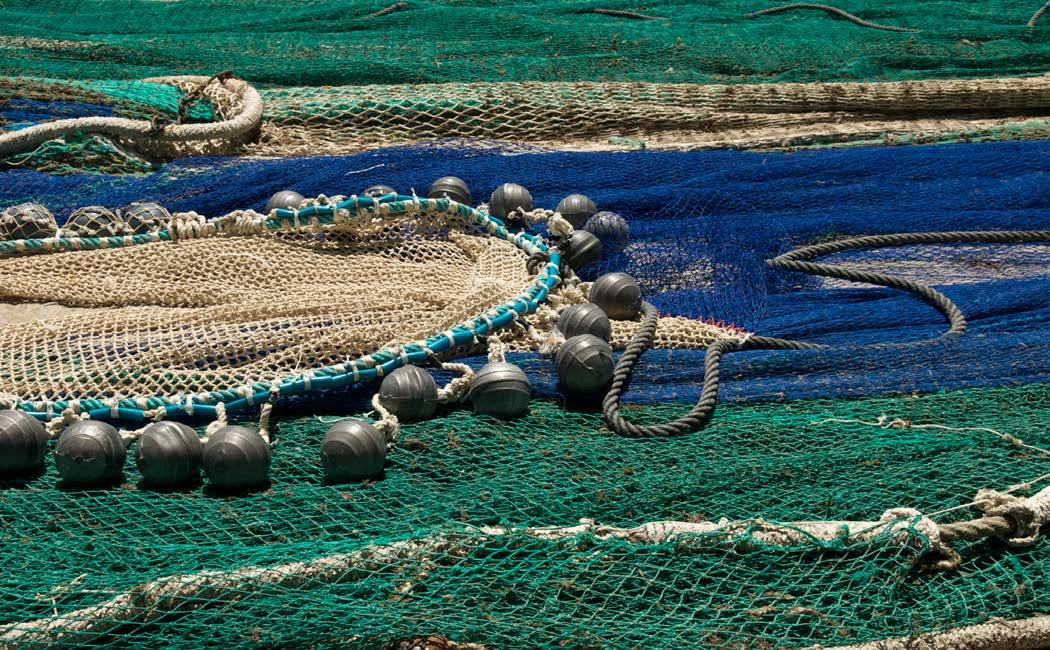
More recently, the extent of the devastation has come into sharper focus. A 2018 study found that deep-sea bottom trawling since 1950 has been
even more destructive than once thought. Seafood lovers would be shocked if they saw the damage firsthand, said lead author Lisette Victorero, a marine ecologist at the National Oceanography Center in Southampton, United Kingdom.
“I don’t think people would be happy to know that hundreds of kilometers of seabed were trawled,” she said, “with hundreds-of-years-old corals and sponges, just for fish.”
SUMMER 2018 | Oceana.org13
Scraping the bottom
The heavy weights on bottom trawl nets pulverize delicate seafloor habitats.
© Oceana/Keith Ellenbogen
A crew member aboard a trawler throws coral back into the ocean. A specimen like this may have taken hundreds of years to grow.

Bottom trawls are bad news for sensitive habitats. The mouth of the trawl net is held open by two “doors,” each of which can weigh several tons. The doors plow up clouds of sediment, which scare fish into the net. Heavy rollers at the net’s bottom hold the gear in place, but also smash through slow-growing deep-sea corals, sponges and other habitat-forming organisms.
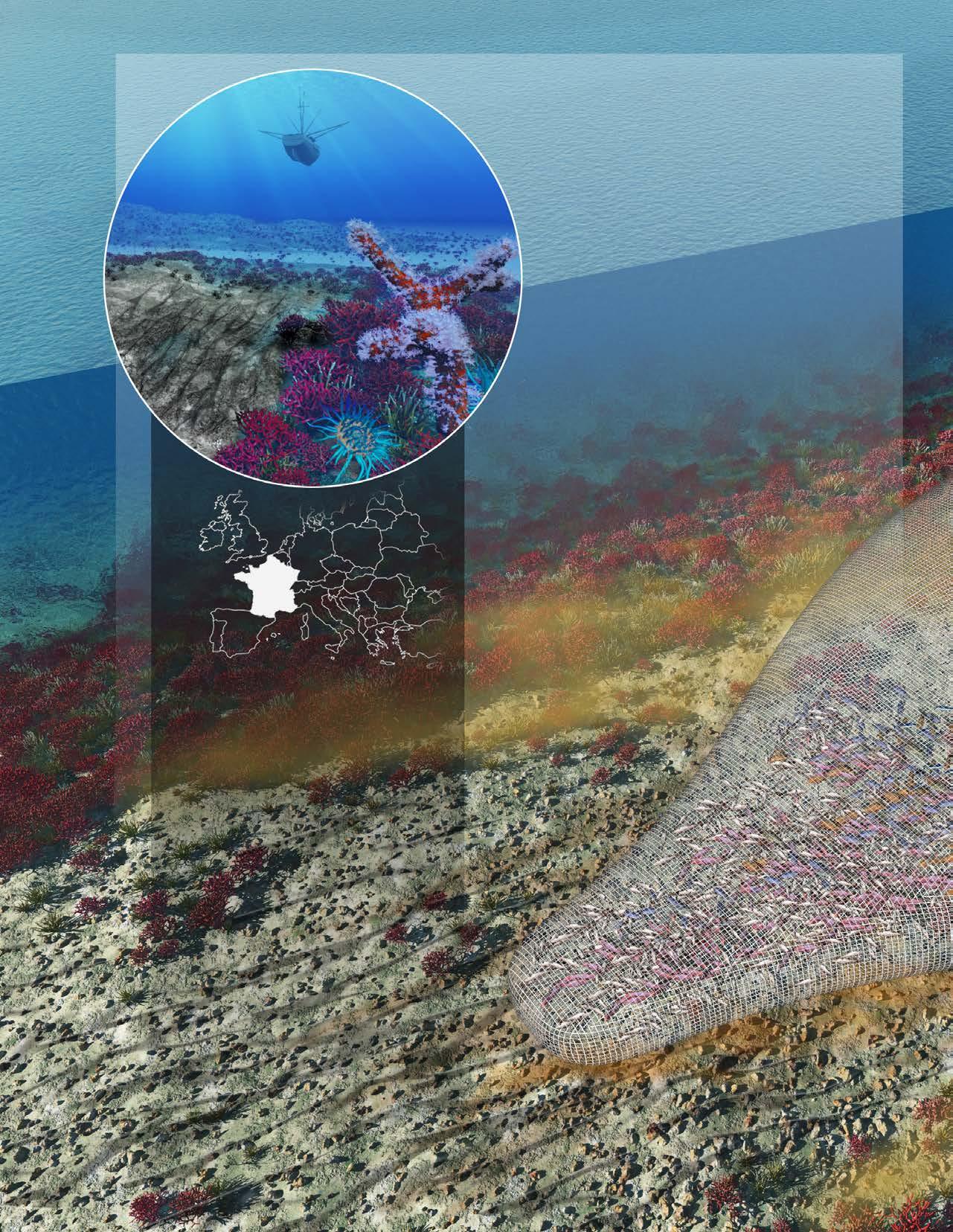
14
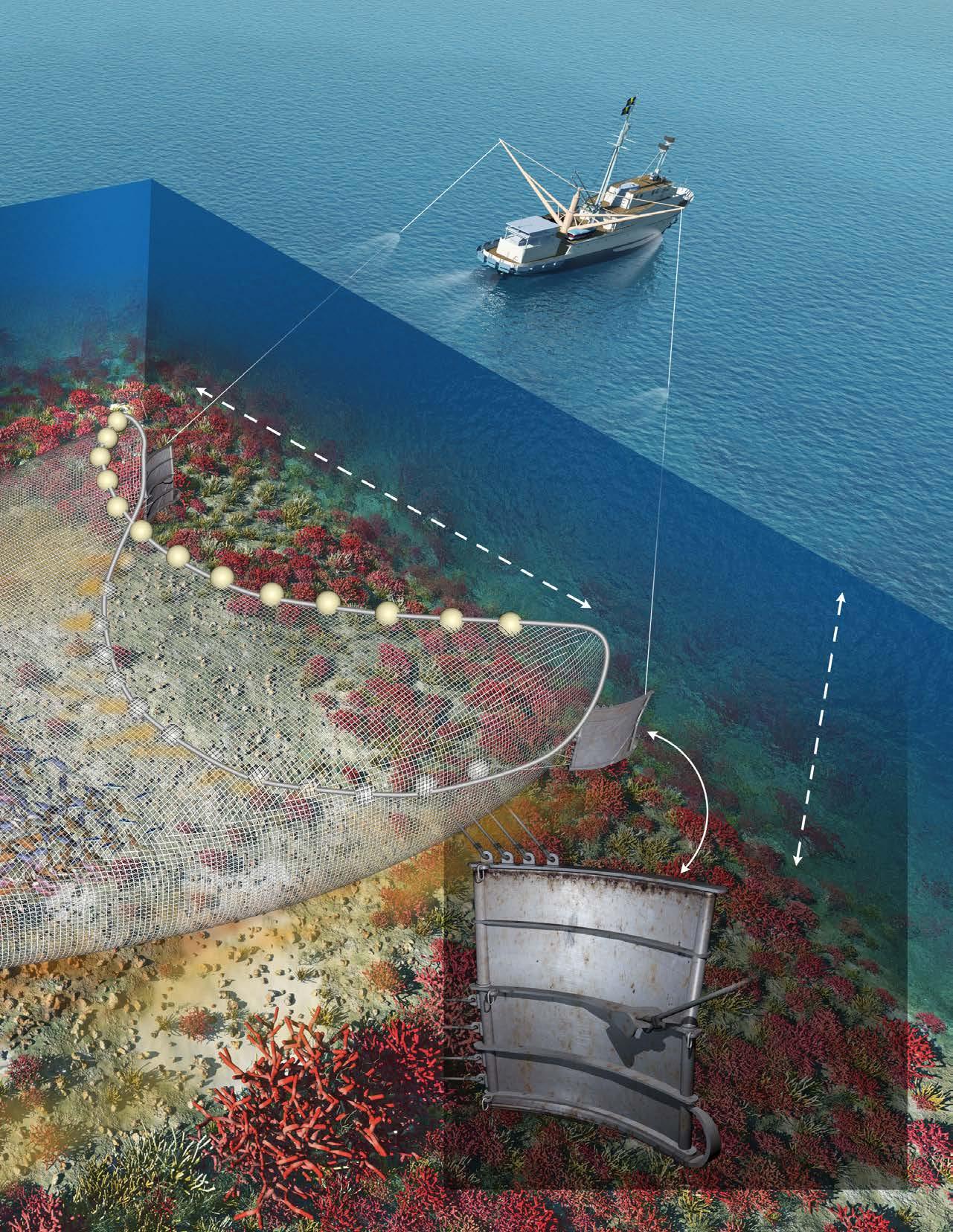
© Oceana/Don Foley SUMMER 2018 | Oceana.org15

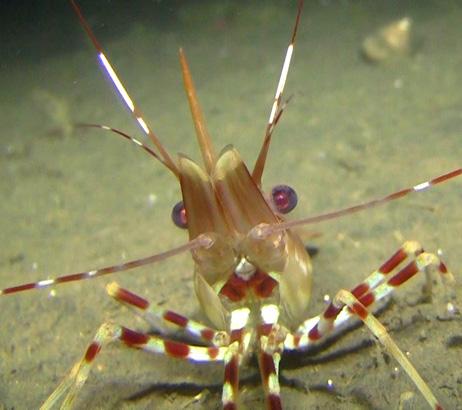
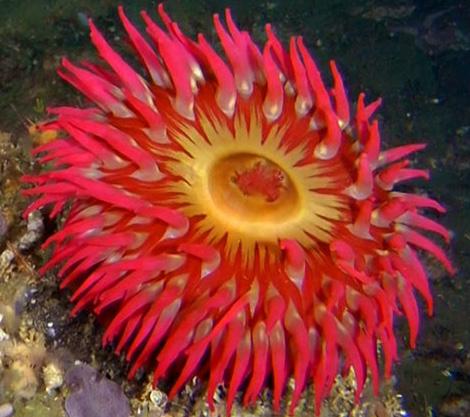
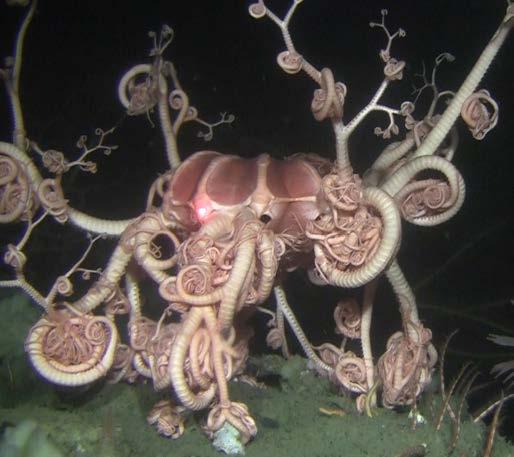


16
Gorgonian coral
Spot prawn
Urticina anemone
Basket star
Deep-sea corals Canary rockfish
©
©
©
©
©
The Tide Turns On Trawling © Oceana
Oceana
Oceana
Oceana
Oceana
Oceana
Winning out west
A few decades ago, the West Coast was wide open to bottom trawling. In one of Oceana’s earliest victories, we protected more than 135,000 square miles (350,000 square kilometers) off California, Oregon and Washington in 2006. Five years later, the Pacific Fishery Management Council, a body of 14 voting members that oversees West Coast fisheries, was due to review those protections.
The council considered proposals from conservation groups and from industry in their review. Fishermen wanted more areas to trawl, while conservationists argued for more closures. After years of back and forth, the council decided this April to protect an additional 140,000 square miles (363,000 square kilometers) of seabed, while opening less-sensitive areas to fishermen. When the National Marine Fisheries Service implements the decision, possibly next year, 90 percent of West Coast state and federal waters, stretching 200 nautical miles off California, Oregon and Washington, will be protected from bottom trawling.
Fisherman Pettinger, one of the council’s 14 voting members, called the decision a bargain between conservationists and trawlers.
“It’s a bargain in the sense that it’s good for both people,” he said. “The sensitive habitat areas primarily have been protected, and areas that can be opened up for the most part were.” The areas slated to open generally have soft, sandy bottoms,
which are less vulnerable to trawling than rocky areas. Access to those fishing grounds will be a boon for West Coast fishermen, Pettinger said.
“It’s a win-win for everybody,” agreed ecologist Brian Tissot of Humboldt State University, who’s studied deep reefs for 30 years and authored a scientist sign-on letter supporting conservation of West Coast seafloor habitats.
“A lot of historically closed areas were opened, so thank God the tradeoff was some new areas were closed,” he said. Protections more than doubled from 2005 to 2018.
Tissot would have liked to see even more closures, especially given the importance of the seabed and how little it’s been explored. He first saw Oregon’s Daisy Bank in the 1990s, and was blown away by the “unbelievable richness” of an oasis where fish lounged everywhere on top of corals and sponges. “Places like that are probably really important,” he said. “It doesn’t make sense to destroy those kinds of habitats.”
Many fishermen would agree. Coming to a compromise on the West Coast sets a positive precedent for cooperation, Pettinger said. “Industry has always been at loggerheads with the environmental movement,” he said. “But realistically, a lot of that back and forth has made this fishery better.”
It’s not just the U.S. West Coast
Oceana safeguards sensitive seabed habitats around the world
In addition to the 140,000 square miles (363,000 square kilometers) off the West Coast in 2018, Oceana has won closures for seabed habitats around the world:
Gulf of Mexico, in June: 300 square miles (800 square kilometers)
Gulf of Maine, in January: More than 25,000 square miles (65,000 square kilometers)
Chile, in 2017: Closed 98 percent of its exclusive economic zone to bottom trawling
European Union, in 2016: Protected 1.9 million square miles (4.9 million) of deep ocean
SUMMER 2018 | Oceana.org17
The Philippine Rise is part of a group of tropical reefs that are deeper, bigger and more diverse than ever expected — and we know almost nothing about them.
18
Shallow-water
coral reefs (0-100 feet) Mesophotic reefs (100 to 490 feet)
Deep-sea coral ecosystems (490 to 6,000 feet)
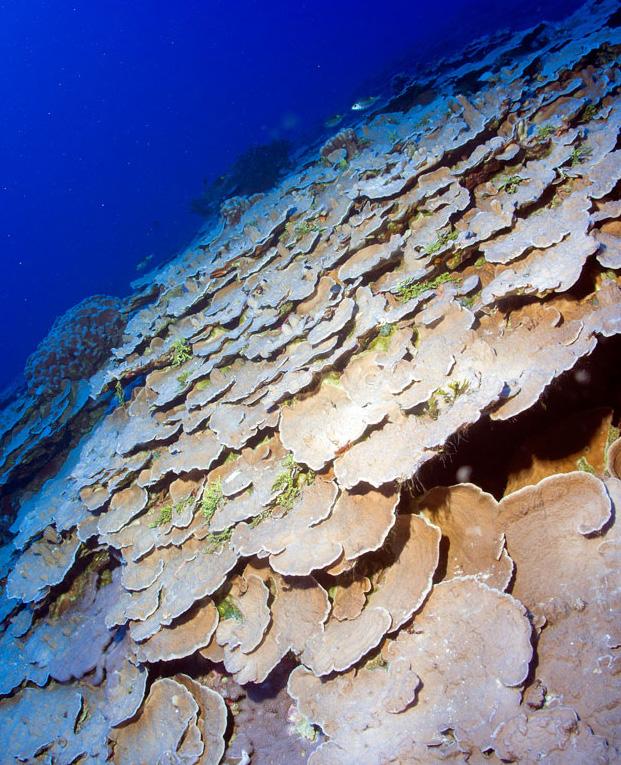
In May 2016, technical divers descended 60 meters (200 feet) to Benham Bank, the shallowest portion of a huge underwater plateau off the Philippines’ northeast tip. As they neared the bottom, an otherworldly landscape emerged from the dim cobalt blue.
Plates of coral grew one atop the other like china at a yard sale, dotted with sea fans and sprigs of algae. Coral columns encrusted in yellow, orange and pink coralline algae looked as though they’d been splashed with rainbow paint. Colonies thrived as far as the eye could see.
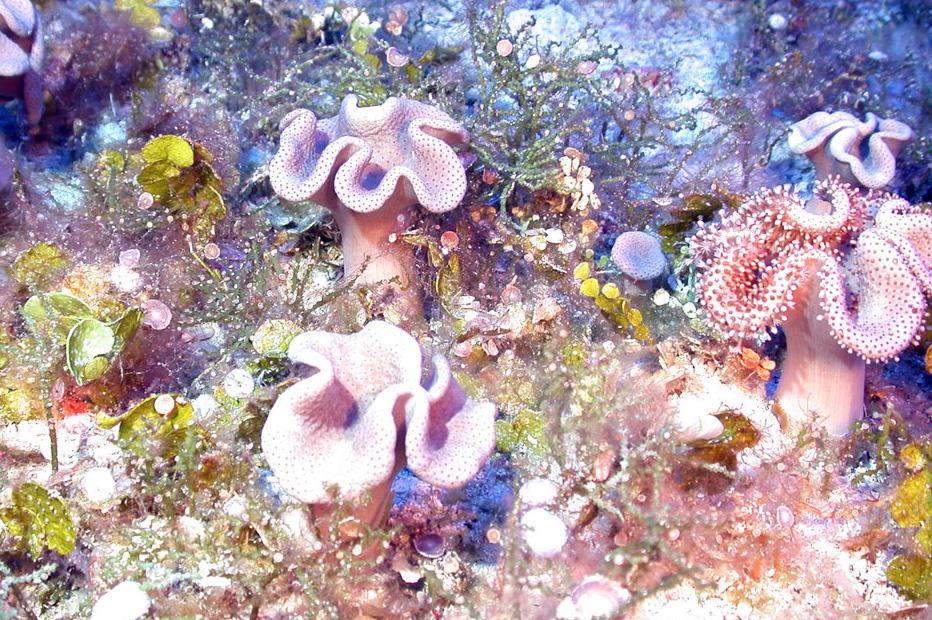
The divers, part of a scientific expedition to Benham, were awed by the reef’s health and size, said Gloria Estenzo Ramos, the head of Oceana in the Philippines. “Our country is at the center of the center of marine biodiversity, but there are almost no more reefs left that we can call pristine,” she said. “At Benham Bank, we found a place that still has 100 percent coral cover.”
Benham lies in the ocean’s “twilight zone” between bright surface waters and the permanent night below. Only in the last decade has technology advanced enough to let scientists venture this deep. Recent discoveries reveal that these little-studied deep reefs are everywhere their sunlit cousins are — and that they’re often bigger, healthier and home to species no longer common in the shallows.
Parts of Benham Bank boast 100 percent coral cover.
Benham Bank hosts diverse coral and algae communities.
© Oceana
SUMMER 2018 | Oceana.org19
© Oceana
Deep Reefs Rising
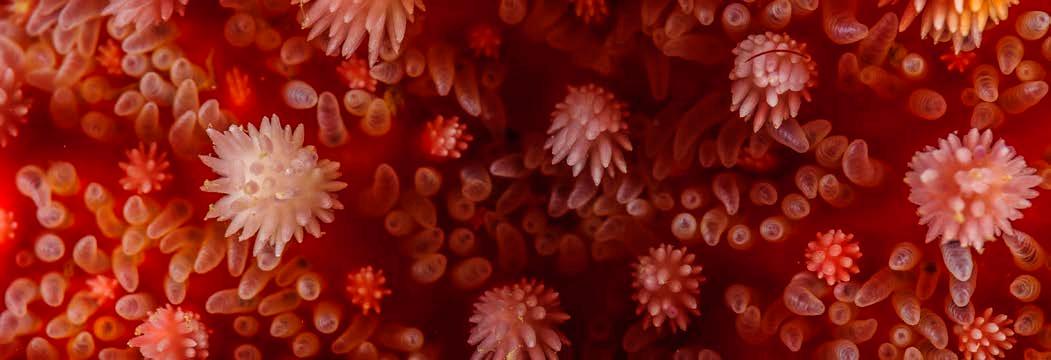
Oceana’s campaign to protect Benham Bank, part of the 240,000-square-kilometer (93,000-square-mile) Philippine Rise, took just two years from start to finish — a whirlwind pace that surprised some government officials, said Gloria Estenzo Ramos, the head of Oceana in the Philippines.
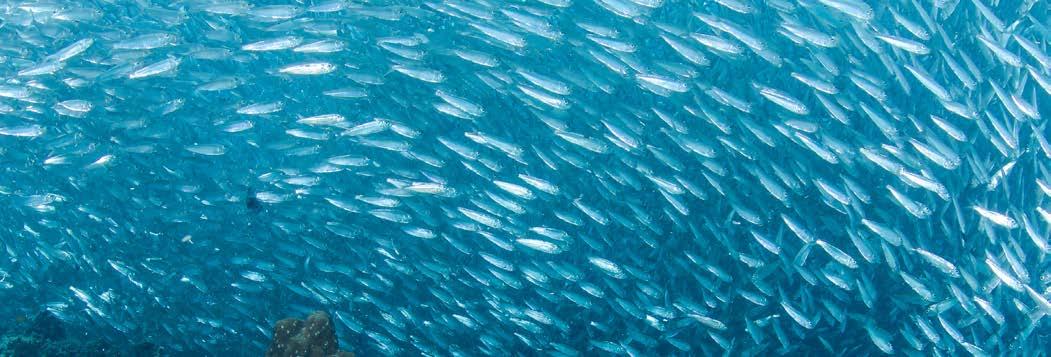
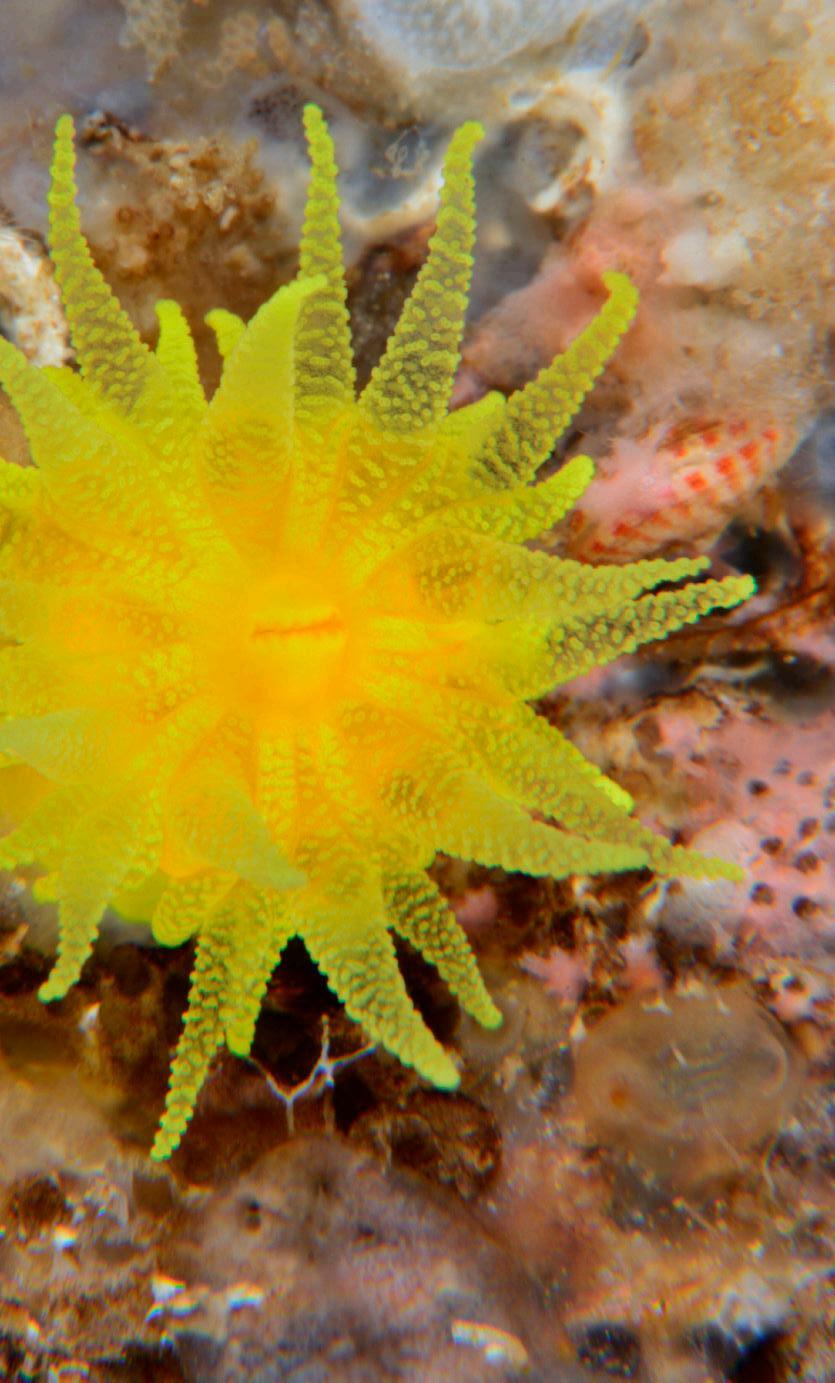
In 2016, Oceana joined a government expedition to
Benham’s reefs as the only civil society representative. The expedition’s photos formed the backbone of the ensuing campaign. Images of vast coral seascapes, crisscrossed by tropical fish, offered a hopeful counterpoint to the torrent of bad news about the world’s reefs.
“It wasn’t difficult to sell Benham,” Ramos said. “The pictures spoke for themselves.”
Fears of Chinese territorial incursion into the Philippine Sea also helped win support for Benham’s protected area designation. “Of all our campaigns, Benham touches a sense of patriotism, a compelling sense of duty,” Ramos said. “It was the common link that bound everybody.”
Beauty and patriotism key to Oceana’s Philippine Rise campaignHOW WE WON IT
20
© Oceana
Lovely, dark and deep
Almost 190 years ago, Charles Darwin dredged up tropical, reefbuilding corals from 128 meters (420 feet) deep. It’s a strange place to find typically sun-loving organisms.
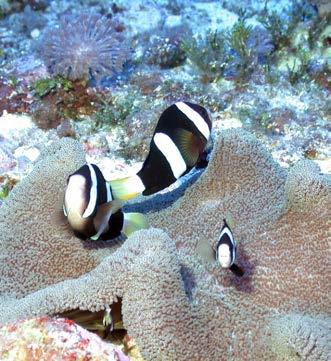
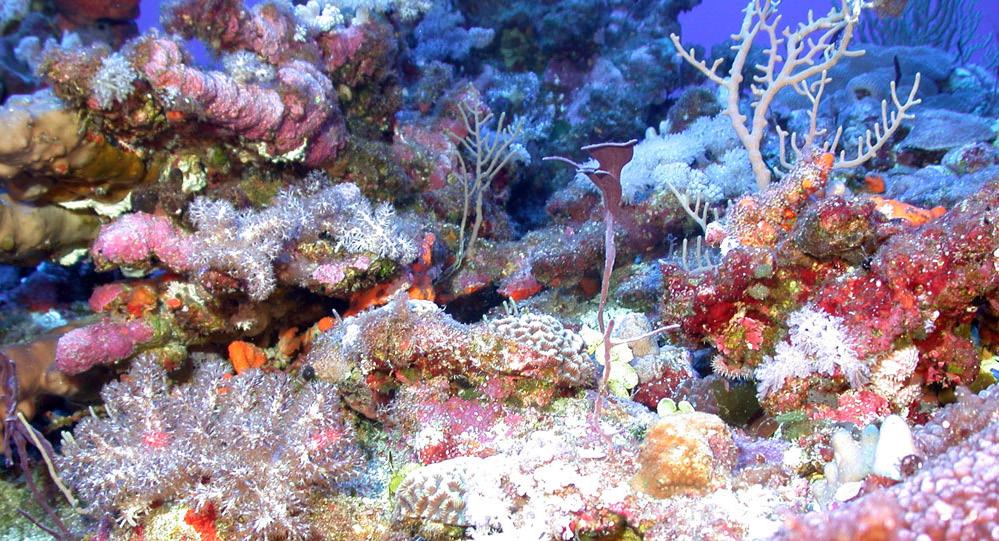
Tropical corals, the kind familiar to scuba divers, all need the sun to survive. Their tissues harbor tiny beneficial algae that convert sunlight into food. Life in the twilight zone’s mesophotic depths — “meso” for half and “photic” for light — stretches this partnership to its limits. Deep-dwelling corals, like those at Benham, grow in plate and lettuce-leaf shapes to expand their surface area and capture as much sunlight as possible.
Corals aren’t the only photosynthetic organisms in the mesophotic zone, a band between 30 meters to 150 meters (100 to 490 feet) deep. Halimeda algae, which look like strands of flat green beads, are common at these depths. For Celia Smith, a reef algae ecologist at the University of Hawai’i at Manoa, light-dependent organisms are just one of mesophotic reefs’ many mysteries.
“How does a photosynthetic organism function in extreme low light?” she asked. “How do they thrive? We’re still at the very beginning of understanding how these ecosystems work.”
Frisky fish
On May 15, Philippine President Rodrigo Duterte put almost 500 square kilometers (190 square miles) of Benham’s reefs off-limits to all human activities except research. A further 3,000 square kilometers (1,160 square miles) of the Philippine Rise, which surrounds Benham Bank, were closed to destructive forms of fishing. This decision safeguards Benham’s delicate corals from bottom trawling and potential threats like mining, and will help preserve the healthy fish communities necessary for reef health.
Duterte’s decision was spurred by a campaign led by Oceana and joined by ally organizations. Oceana launched its conservation efforts soon after the May 2016 scientific expedition, where the team provided technological assistance. The campaign got a boost in December 2016, when the Convention on Biological Diversity declared Benham to be of “critical ecological importance.”
Clark’s anemonefish
SUMMER 2018 | Oceana.org21
© Oceana
Deep Reefs Rising
Mesophotic reefs like Benham aren’t just important habitats for corals and algae. Their intricate topography shelters fish and other animals as well. Some fish species are familiar from the shallows, while others, like a newly identified butterflyfish from the Philippines, are unique to the mesophotic zone.

These smaller fish attract bigger fish, like groupers, snappers and sharks, many of which are important for local food security and incomes. “When you protect
these reefs, you get a huge benefit in terms of fisheries species buildup,” said Tyler Smith, a coral reef ecologist at the University of the Virgin Islands in St. Thomas, who is not related to Celia Smith.
So far, over 200 fish species have been documented on the Philippine Rise. This vast submarine formation hosts the world’s only confirmed spawning ground for Pacific bluefin tuna, a lucrative species that’s plummeted to just 3 percent of its pre-fishing abundance.
Safeguarding mesophotic spawning sites pays off, Tyler Smith explained. In the Virgin Islands, after 20 years of protection, endangered Nassau grouper are returning to mating spots once decimated by overfishing. “We’re starting to see their numbers rebound, and you now see them not so uncommonly in shallow waters,” he said. “They’re slowly coming back to being a viable species.”
Hawkfish are typically found on shallow reefs. This one was spotted on Benham Bank, 60 meters (200 feet) deep.
22
©Oceana / Karl Hurwood
Mesophotic reefs are important nurseries for young animals, like this juvenile emperor angelfish.
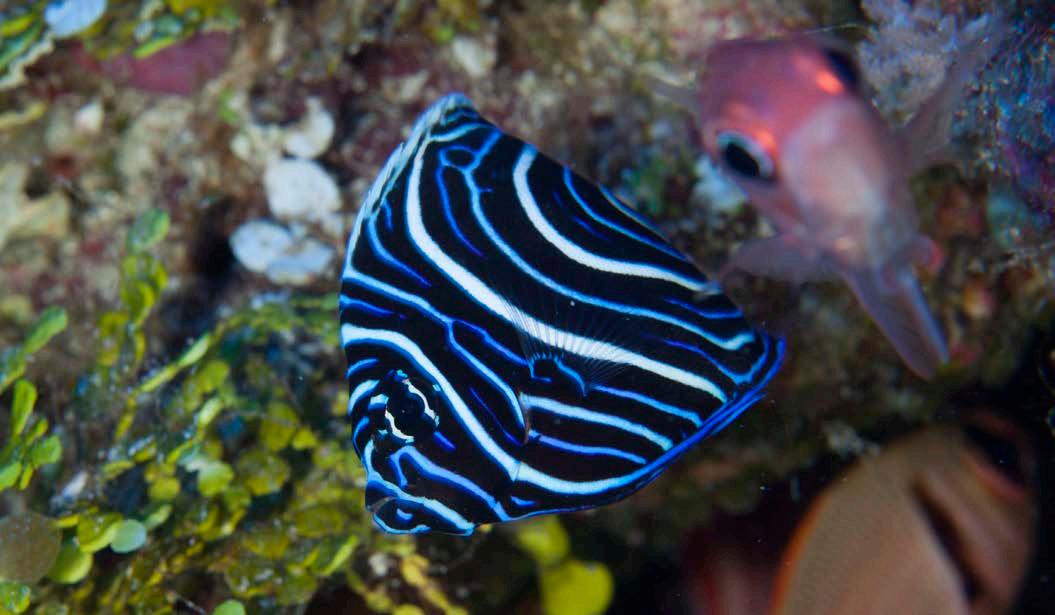
Most of the over 500 species of wrasse live in tropical and subtropical waters.
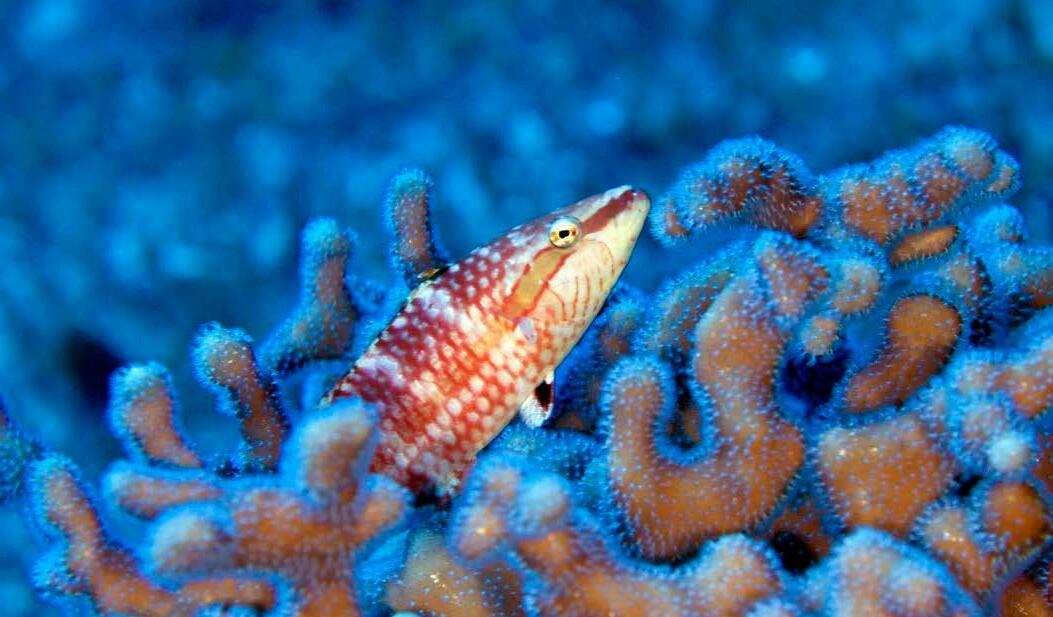 ©Oceana / Karl Hurwood
©Oceana / Karl Hurwood
SUMMER 2018 | Oceana.org23
©Oceana/UPLB
Deep Reefs Rising
More than meets the eye: Mesophotic reefs can be more extensive than their shallow cousins.
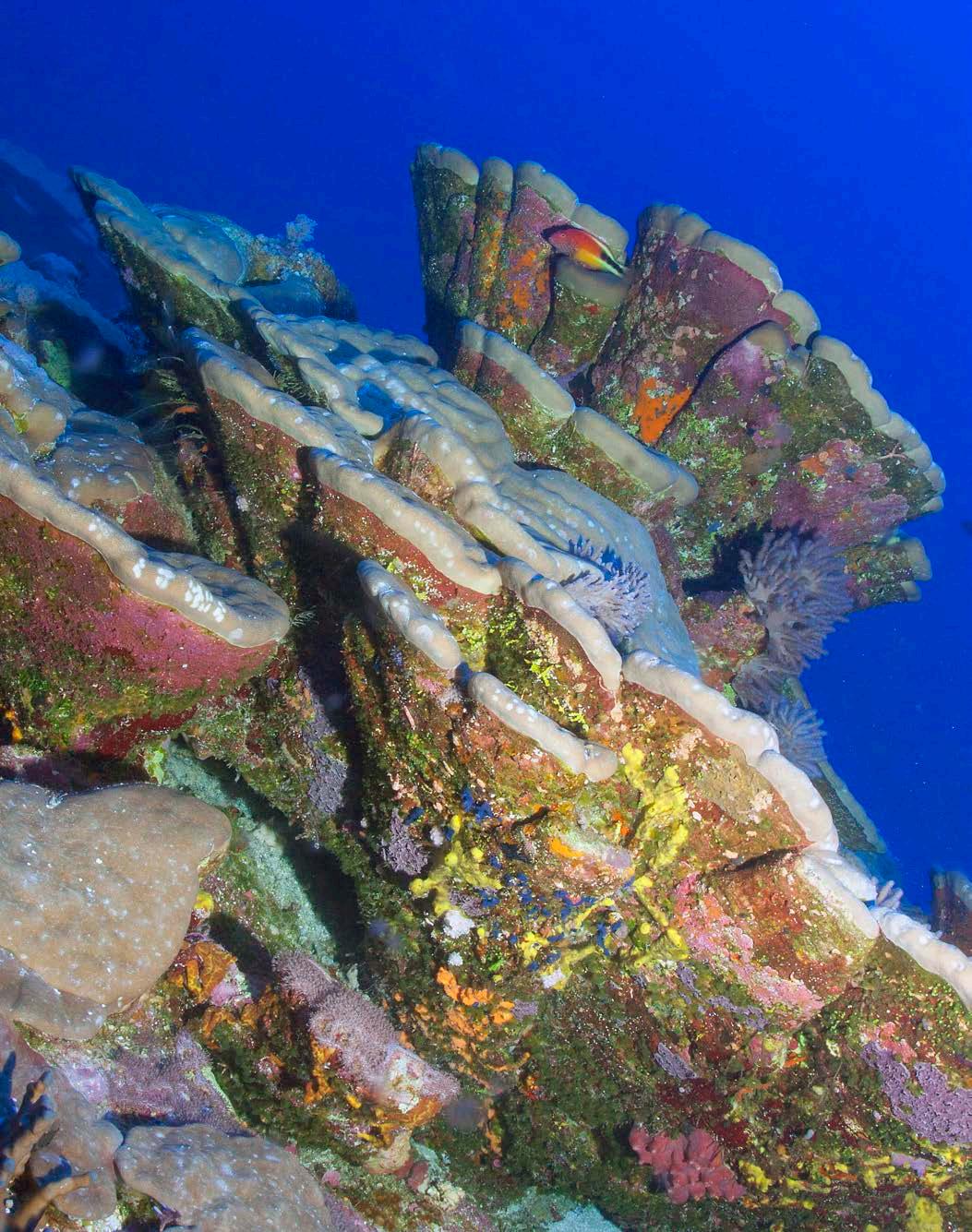
24
©Oceana / Karl Hurwood
Shelter from the warm
Benham is just one of a vast network of mesophotic reefs that could benefit from protected status — and protection begins with simple knowledge of their existence.
When Smith and his colleagues surveyed the ocean southwest of St. Thomas in the U.S. Virgin Islands, they were surprised to find that a single mesophotic reef system was “more extensive and well-developed” than all the islands’ shallow reefs combined, with potentially hundreds of millions of coral colonies. On top of this, he said, the deeper ecosystems harbored a species of boulder coral that’s all but vanished from the Caribbean’s struggling surface reefs.
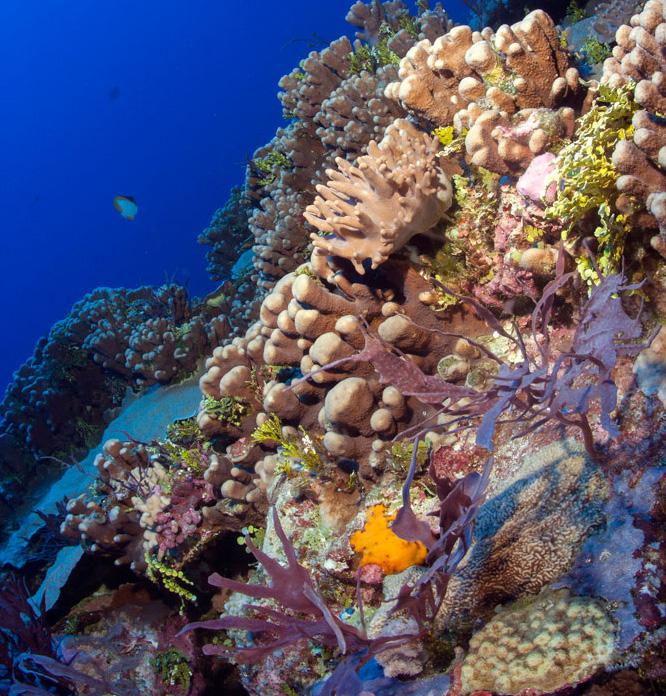
St. Thomas isn’t the only haven for rare coral. In Panama and the Galapagos, a species of fire coral is thought to vanish from the shallows during the unusual warmth of the El Niño weather phenomena, only to be re-seeded from deeper-living specimens later on.
Examples like these have led scientists to debate whether mesophotic reefs can shelter reef species from climate change, like a Svalbard Seed Vault for corals. So far, the answer has been “it depends.”
During the recent disastrous bleaching that wiped out one-third of Australia’s Great Barrier Reef, some mesophotic corals appeared to fare better. But in other parts of the world, mesophotic reefs are more imperiled than shallow ones. That’s because twilight corals aren’t acclimated to the dramatic temperature swings that can batter reefs up-top. How well mesophotic reefs fare depends on local ocean conditions, like deep, cool currents, which can mean the difference between life and death.
Corals’ complex structures shelter fish and other animals.
Deep thinking
There’s no debating that twilight zone reefs have one major advantage on their side: distance from us. Living at a remove from humans helps insulate them from coral-killers like bottom dredging, coastal development and agricultural runoff. It’s also tougher to fish at mesophotic depths, said Taylor Smith, so these reefs often host bigger and more abundant fish.
Smith’s big fear is that fishing gear and other technologies will advance to the stage that mesophotic reefs will lose their built-in safeguards. This makes legal protections, like those on Benham, all the more vital.
Even if we don’t fully understand these reefs, said Celia Smith, the algae ecologist, that’s no reason to ignore them. “It’s the precautionary principle,” she said. “These reefs could have a significant role in the future.”
SUMMER 2018 | Oceana.org25
©Oceana / Karl Hurwood
Deep Reefs Rising
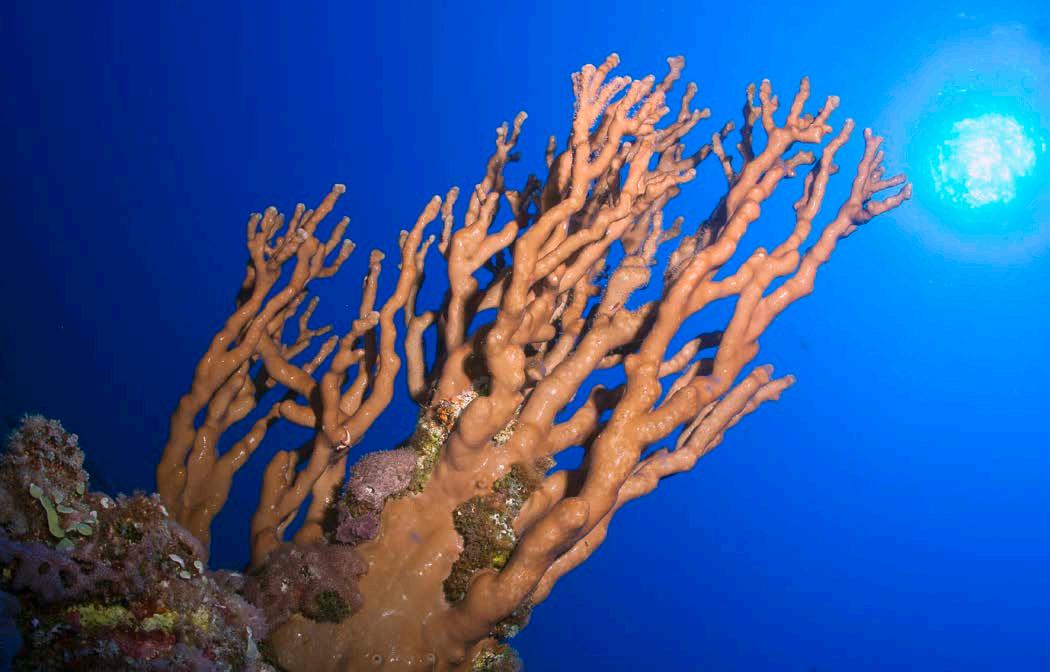
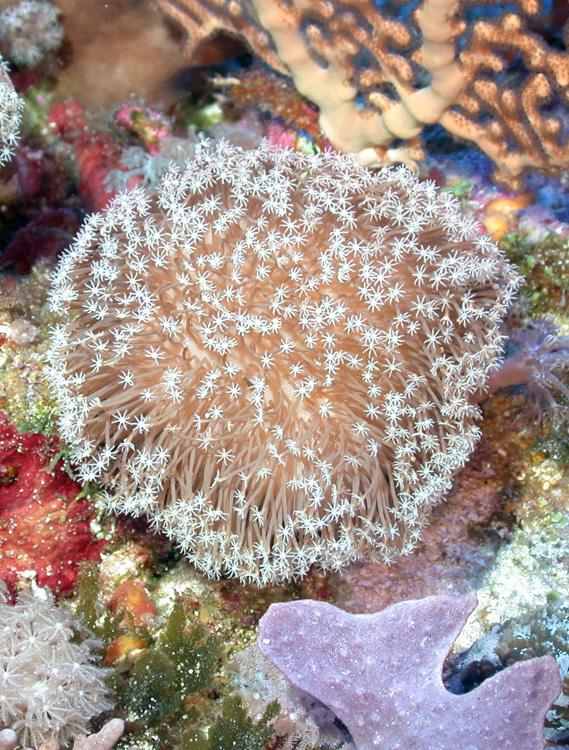
Fire corals aren’t true corals, but are more closely related to hydrozoans such as the Portuguese man o’war.
Despite the low light, photosynthetic corals and algae thrive at mesophotic depths.
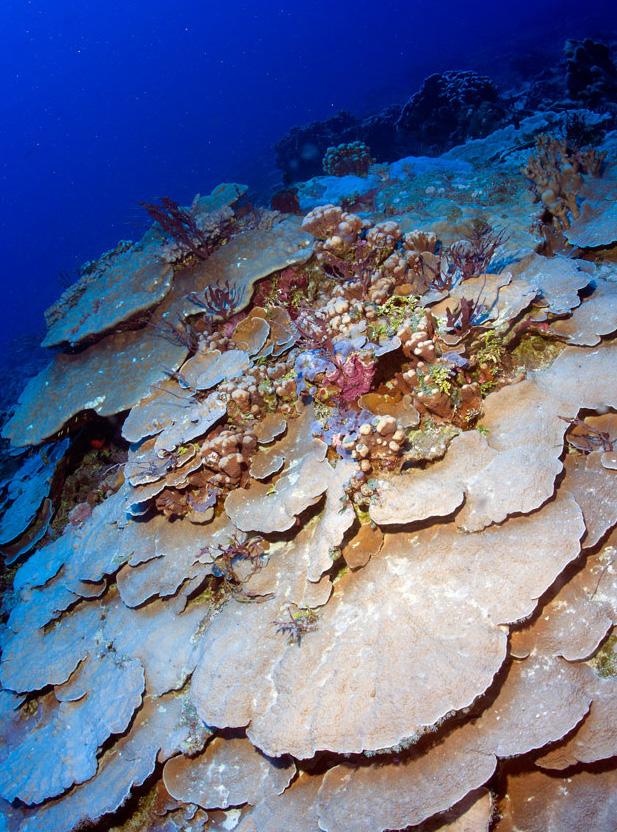 A Sarcophyton coral extends its polyps to feed.
©Oceana / Karl Hurwood
©Oceana / Karl Hurwood
A Sarcophyton coral extends its polyps to feed.
©Oceana / Karl Hurwood
©Oceana / Karl Hurwood
26
©Oceana / Karl Hurwood
2017 - 2018 Victories
June
• Malta expands habitat protections in Mediterranean May
• Brazil introduces first-ever management rules for tainha, begins science-based management of Its fisheries
• Philippines creates Benham Bank protected area to safeguard unique habitat, corals and more
April
• More than 140,000 square miles of fragile seafloor habitats protected from destructive bottom trawling off U.S. Pacific coast
February
• Chile announces protected area in Tortel to preserve pristine habitat
• Chile protects Juan Fernandez Islands and wildlife found nowhere else on Earth January
• Belize bans offshore oil drilling, protecting the largest barrier reef in the Americas
2017 Continued
November
• The Philippines appoints a special prosecutor to prosecute illegal commercial fishing in one of the country’s largest marine protected areas
September
• European parliament acts to end overfishing in the North Sea
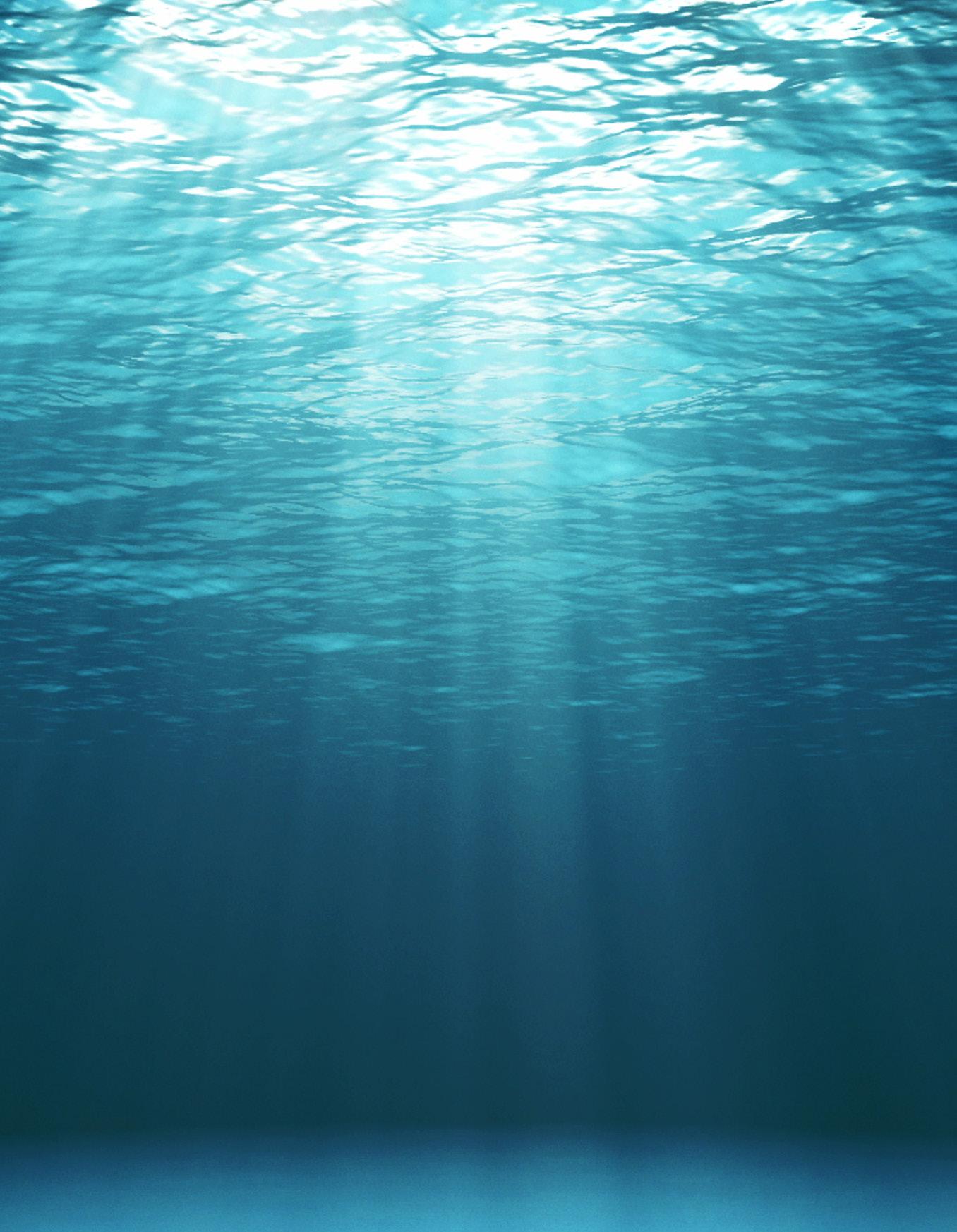
• Peru agrees to publish vessel tracking data through global fishing watch to help fight illegal fishing
August
• Chile rejects major industrial port mining project that threatened penguins, whales and fragile habitat
• U.S. court upholds rule requiring traceability for at-risk seafood imports July
• Chilean supreme court forces salmon farming industry to disclose antibiotic use
June
• Legal reform makes EU’s external fishing fleet more transparent, accountable and sustainable
April
• U.S. takes action to protect west coast sardines from overfishing for third consecutive year
• California moves to protect hundreds of forage fish species in state waters March
2017
December
• Canada acts to make the status of fisheries more transparent to its citizens
• Chile protects ocean habitat and wildlife, bans bottom trawling in 98 percent of its seas
• 21 countries and the EU protect endangered coldwater corals throughout the Mediterranean
• New pact commits nations to rebuilding a healthy Mediterranean Sea February
• Philippines’ protected area management body adopts vessel monitoring requirement in the Tañon Strait to combat illegal fishing
January
• President Obama protects fish, whales and more from dangerous seismic airgun blasting in the U.S. Atlantic Ocean SUMMER 2018 | Oceana.org27
Supporter Spotlight
For the Rothwell Family, A Legacy of Giving
Susan Rothwell jokes that her husband, Jim Rothwell, was a fish in his past life, and she might be right. She and Jim live with their three children on the coast of Connecticut. Jim might have to take a threehour round trip to get to his office in Manhattan, but getting to live on Long Island Sound is worth the trek. And if it’s not the Sound, it’s another body of saltwater. “It’s impossible to take a vacation in a land-locked country,” Susan laughed.
The couple has life-long ties to the sea. Susan grew up in Southern California, where she learned to swim in the big waves of the Pacific. Jim was raised along Long Island Sound in a family of fishermen, sailors, scuba divers and surfers. The couple’s love of all things ocean has rubbed off on the kids. Zach, 16, scuba dives with his dad, and the 3-year-old twins, Finn and Connor, boogie board in the ripples on the beach near their home.
Their perch on the edge of Long Island Sound has given them front-row seats to ocean wins and losses. As a boy, Jim would watch trawlers chug past and think to himself: “They’re stealing our fish.” Local fish abundance has declined noticeably within his lifetime. But there’s good news too. Recently, smarter management of menhaden — a small, oily fish that’s the foundation of East Coast marine ecosystems — means that the Rothwells now spot “huge” schools of this essential species.
The Rothwells’ passion for the sea also manifests in their philanthropy. Their relationship with Oceana began with their oldest son, Alex, who tragically passed away in 2013 at the age of 13. When Susan and Jim began a tradition of letting Alex and Zach donate to a charity each holiday season, Alex chose Oceana. After his death, friends and family were invited to honor his legacy by donating to Oceana as well.
Now, by making a substantial investment in Oceana, Jim and Susan are proud to uphold the tradition that Alex began. “We believe very strongly in what Oceana’s doing,” Susan said. “We’re extremely happy to be part of the effort.”

At the small asset management company where Jim works, the motto is “Focus. Be Humble. Be Kind.” A similar attitude imbues the family’s vision for the world’s oceans. They would like to see reefs regain their health and beauty, and marine fisheries become a permanent, sustainable food source. “There’s nothing more important than keeping the ocean healthy,” said Susan. Jim added: “And it’s a problem that seems like it can be solved.”

28
Susan and Jim Rothwell
Susan and Jim with twins Finn and Connor
Kira Cahill and Olivia Dahan
Best friends Olivia Dahan and Kira Cahill didn’t meet through standard friend factories like college or a neighborhood hangout. Instead, their “eyes met” across the room at an Oceana fundraiser in Los Angeles, California. Granted, it wasn’t hard to spot one another — they were the only two there under the age of 40.
Dahan and Cahill discovered they had more in common than just their age. Both are ardent ocean advocates. Cahill, an actress, hails from Laguna Beach, California, where the ocean has been a source of succor throughout her life. Her family have been generous Oceana supporters for over 12 years.
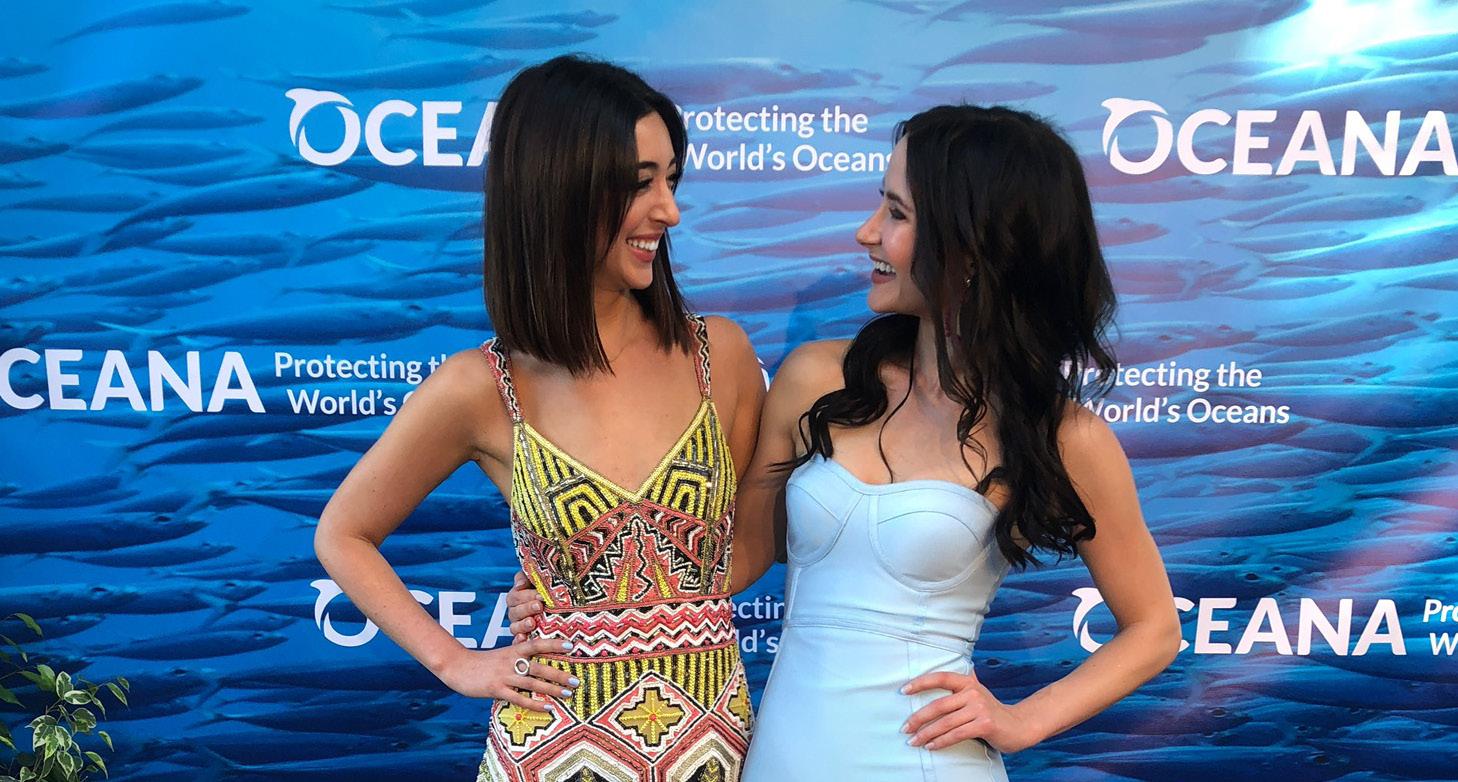
Dahan, now a film producer, grew up sailing, rowing and lifeguarding off Newport Beach, California. She got involved with Oceana after volunteering at a SeaChange event, where she was “stunned and overwhelmed” by the threats facing the ocean. She founded the first collegiate branch of Oceana soon after, at Connecticut College.
Dahan and Cahill’s mutual love of the sea and philanthropy led them to found the Oceana Young Leaders Council four years ago. The council aims to get the younger generation on board — sometimes literally — with ocean conservation.
In June 2016, the pair headed out on a boat with 20 young influencers and Geoff Shester, Oceana’s California campaign director and senior scientist. Embarking from Marina del Rey in Los Angeles, the trip offered a fresh perspective on the beauty and wildness of the California coastline. The journey proved an emotional one too: When a pod of dolphins surfaced nearby, a new transplant from Tennessee cried with joy.
“People want to care, people do care,” Cahill said, “but people need a helping hand.”
The pair have also organized a film screening, a clean-up day at a local state beach and an anti-bullying event, and have designed t-shirts to draw attention to the shark fin trade. Their advocacy work spills over into their social lives as well. They’re known among their friends as “the straw moms,” who spread a just-say-no approach to single-use plastic straws, a common contaminant in ocean environments.
There’s a serious vision underpinning Dahan and Cahill’s innovative approach. They see special value in outreach to members of the Oceana Young Leaders Council, some of whom are just 15 years old. Ocean conservation is not something that most kids learn about in school, they emphasized. Experiences like an inspiring boat trip or film screening will stick with them for life. “There’s a huge power in the younger generation,” Cahill said. “The ocean is going to be in great hands.
SUMMER 2018 | Oceana.org29
Olivia Dahan and Kira Cahill
Dr. Pauly What Are Stock Assessments?
One of the major tasks that fisheries scientists face, once they have documented a fishery’s catch and fishing effort, is assessing the abundance, or “biomass,” of the population, or “stock,” of fish that the fishery exploits.
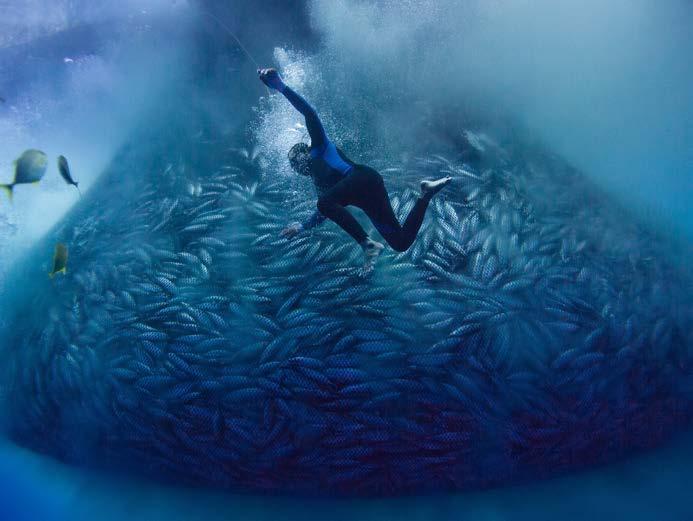
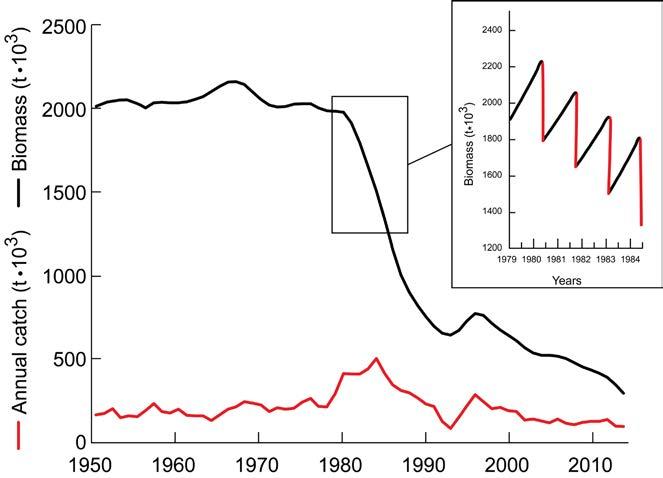
The goal here is to optimize the fishery, that is, for the catch to be set as high as possible but not so high that the population risks crashing, or cannot recover if it has previously been overfished. This is called the maximum sustainable yield, or MSY.
The stock assessments themselves are based on “fisheryindependent” information obtained from research vessel surveys and complex computer models that integrate into a single framework the survey results with “fishery-dependent” data, such as the age and number of the fish that are caught and the number and properties of fishing gears. From this, and a vast number of assumptions, the presumed abundance of the stock and the suggested quota for the following year can be inferred.
Classical stock assessments, therefore, are not only extremely expensive — a research vessel survey lasting a week can cost several hundred thousand dollars — but also very demanding in terms of data and expertise. Thus, they are performed mainly in wealthier countries.
30
A diver helps corral skipjack tuna in the Philippines. Fisheries in less-developed nations are often data-deficient.
©Oceana
For the rest of the world simpler methods, often rules of thumb, have been used to assess stocks, and their inaccuracies have led to a situation where many countries overfish their marine resources without realizing it.
This can be overcome, however, through the development of methods suitable for use in data-sparse situations. A new approach, the CMSY method, infers a fishery’s MSY from catch data — hence the acronym.
Essentially, the CMSY method requires only a computer and a time series of catch data, typically 20 or more years. Then, it proceeds as follows (warning: some math to follow):
1. Assume a carrying capacity (k) which equals the level of abundance, or “biomass,” of a given species that can be accommodated in a given ecosystem, corresponding to the mean abundance of that species before it was exploited by the fishery.
2. Subtract the catch of the fishery’s first year from the carrying capacity of that fishery (k).
3. Multiply that remaining biomass by the species’ growth rate (r), which is reduced by the fact that biomass is close to carrying capacity.
4. Subtract the catch of the second year from the product of r times the residual biomass.

5. Repeat 3 and 4 for each year, taking account of the fact that r varies when the biomass changes.
Depending on the initial values of the carrying capacity and the species growth rate, this procedure will either crash the population (more catch will be removed than can be compensated for by biomass growth) or the population will remain present, or viable.
These steps are then repeated for a wide range of values. The few values of k and r which allow for population viability are averaged, and the averages are retained as best estimates. This might require 10,000 or more runs of steps 1 – 5, but computer time is cheap, and it can be substantially reduced by studying ranges of values previously known to produce viable trajectories.
The point is that, with catch data, and given simple constrains, one can estimate the carrying capacity and population growth rate. From these, MSY can be computed. Also, for every year with catch data, the ratio B/BMSY, that is, a measure of the abundance of fish (B) relative to that which allows MSY to be taken (BMSY) can be calculated, and used to set quotas.
The Sea Around Us initiative, with Oceana’s support, has recently applied this method to the overwhelming majority of stocks contributing to the global fish catch, with catch data covering the years 1950 to 2014 — longer than for most stock assessments. The results can be found on seaaroundus.org for each of the world’s marine ecoregions, providing useful data for sciencebased fisheries management at national and international levels.
1 I will spare you the equations required to do this. Also, this presentation of the CMSY method is simplified; there is more to it than presented here, but it is still simple in principle
Palomares, M.L.D., R. Froese, B. Derrick, S.-L. Nöel, G. Tsui, J. Woroniak and D. Pauly. 2018. A preliminary global assessment of the status of exploited marine fish and invertebrate populations. Sea Around Us Report to Oceana, 60 p.
SUMMER 2018 | Oceana.org31
Dr. Daniel Pauly is the founder and director of the Sea Around Us project at the University of British Columbia’s Institute for the Oceans and Fisheries, and is a member of the Oceana board.
SeaChange Summer Party
Oceana’s 11th annual SeaChange Summer Party, held on July 21, at a private Laguna Beach estate, raised over $1.3 million in support of local, national and international marine conservation. Co-chaired by Oceana Board member Valarie Van Cleave and Elizabeth Wahler with Vice Chair Jeff Blasingame, the gala featured a special performance by singer, song-writer and actress Katharine McPhee.
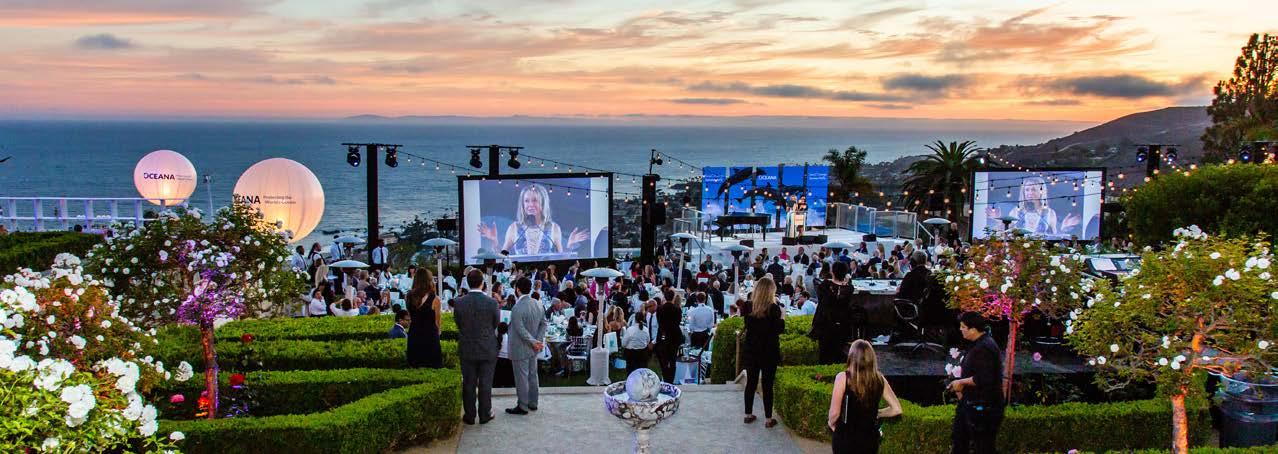
“A healthy ocean is every child’s rightful inheritance,” said Wahler. “And healthy oceans start with healthy coral reefs. They’re home to innumerable species that support entire food webs.”
“Oceana’s teams are winning battles that will give the corals a chance,” said Oceana CEO Andrew Sharpless, continuing the evening’s theme of coral conservation. “We’re fighting to stop expanded ocean oil drilling — a real threat that exists right here off the entire California coast. We’re also fighting to stop coral-destroying bottom trawling. And we’re winning, including recent victories in Chile and the Philippines and new protections for 16,000 square miles right offshore here.”

Engaging the audience in a powerful call to action, Sharpless encouraged the 400 guests to sign cards to ban the sale and trade of shark fins in the United States. He followed up his remarks by using his cell phone to record a video of the guests cheering out, “thank you!” to Congressman Ed Royce for his support of the ban.
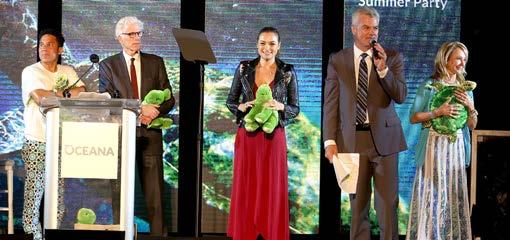
Actor and Oceana Board member Ted Danson emceed the evening and recruited the help of fellow actors Oscar Nunez and Christina Ochoa, along with Valarie Van Cleave, to encourage guests to symbolically adopt a sea turtle to raise critical funds for the SeaChange mission.
“Every year, I am so inspired by the generosity and spirit of this community,” said Van Cleave. “For more than a decade, the people of Orange County have come together to support healthy oceans. I am humbled by their continued support and thank everyone who came to this year’s SeaChange.”
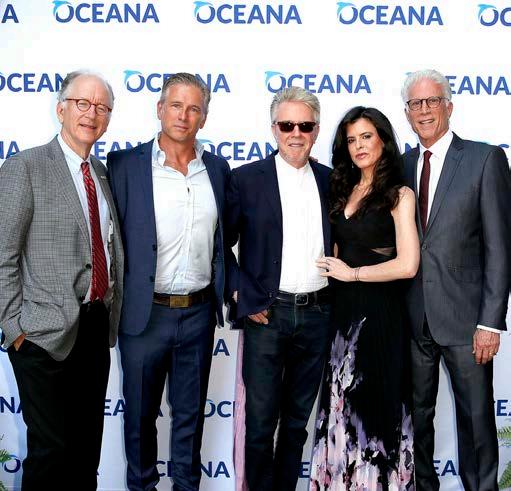
32 Events
Oscar Nunez, Ted Danson, Christina Ochoa, and Valarie Van Cleave help with the adopt a turtle drive.
Andy Sharpless, J Nichols, Keith Addis, Keri Selig & Ted Danson
©John Shipton Watkins
©Tom Vickers
©Tom Vickers
©Tom Vickers
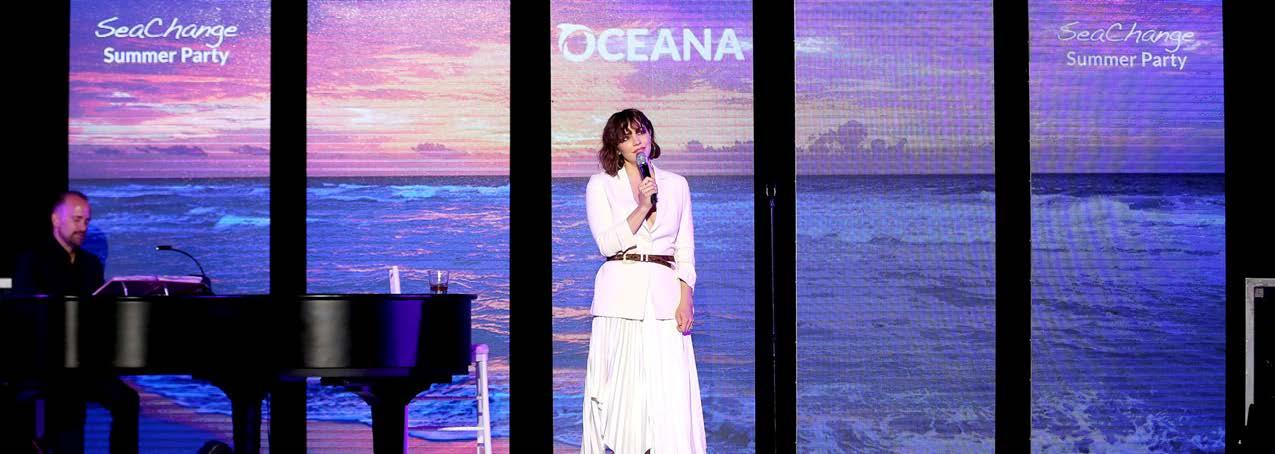

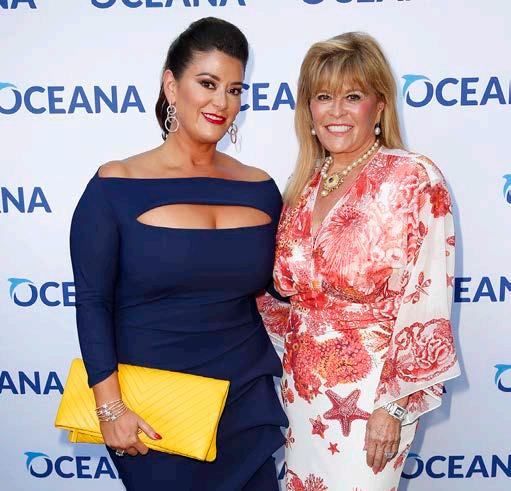
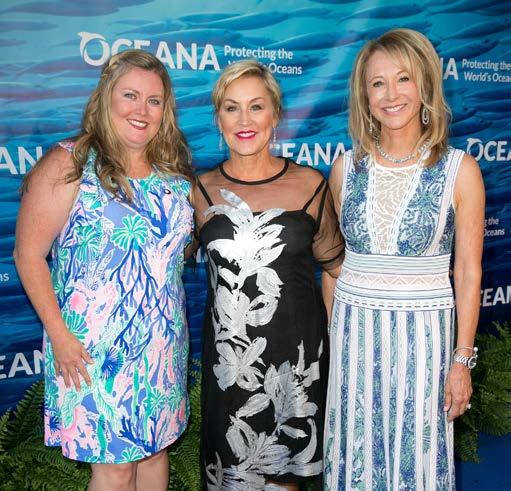
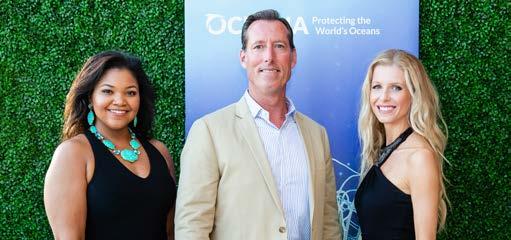
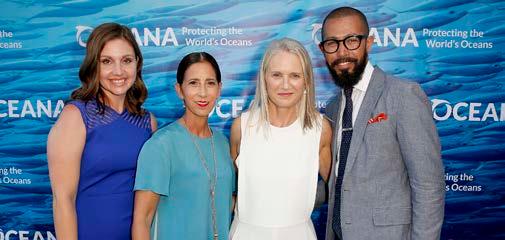
SUMMER 2018 | Oceana.org33
Dennis Haysbert
Lace Alexander, Christian Bakewell & Louise Tilley of Burgess Yachts
Elizabeth Wahler & Valaree Wahler
Katharine McPhee captivates the audience at the SeaChange Summer Party.
One Ocean Beauty
Sara Lowell, Jean Weiss & Valarie Van Cleave
©Tom Vickers
©Tom Vickers
©Tom Vickers
©John Shipton Watkins
©Tom Vickers
©Tom Vickers
©Tom Vickers
Events
Dead & Co. at Rock Under the Stars
On July 8, Oceana Board President Keith Addis and Keri Selig hosted Dead & Co. at the third annual Rock Under the Stars. The event, held at their beautiful Hollywood, California home, raised over $1.1 million in support of Oceana’s campaigns.
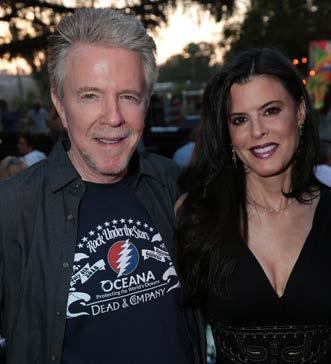
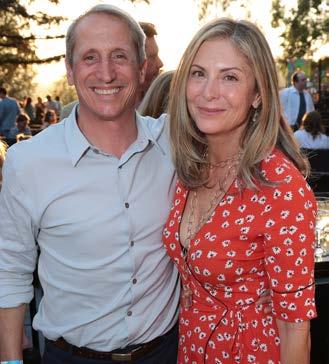

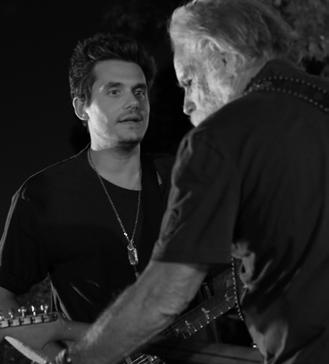
This was the band’s first charity performance since forming in 2015. Dead & Co., consisting of former Grateful Dead members Bob Weir, Mickey Hart, and Bill Kreutzmann, along with John Mayer, Oteil Burbridge, and Jeff Chimenti, played a 65-minute set which included Samson & Delilah, Brown-Eyed Women, and When I Paint My Masterpiece.
Andrew Sharpless, Oceana’s CEO, informed guests about current threats to our oceans, including the weakening or abolishment of key environmental legislation by Congress and the Trump administration. He also addressed plastic pollution, asking the crowd: “How many plastic bottles do you think were produced last year? Coca-Cola alone produced 110 billion. Just last year. Half of all the plastic ever made was produced in the last 15 years. And much of it ends up in the ocean, where it kills for centuries.”
Drummer Mickey Hart explained, “we don’t do that many [benefits], especially house parties. It seemed like the right thing to do at the right time. The oceans are really in need.” He went on to say in an interview with BillBoard, “you got to defend the treasures. One of them is the oceans and you have to defend it however you can.”
Addis credits his friend, the band’s manager Bernie Cahill, with making the concert happen. “Normally, it takes me a couple of months to lock down the talent. This time it was the very first call I made and Bernie said: ‘Sounds like a great idea. Let’s do it.’ Cahill said of the band, “Bill lives in Hawaii, Bob lives on the water. Oceana really resonated with them.”
Addis congratulated The Dead for having been on the front lines of progressive social activism since the 1960’s — and for stepping up again now for the world’s imperiled oceans.
He urged the audience to join the band and Oceana in this crucial work at a pivotal moment in our history.
34
John Mayer and Bob Weir
Keith Addis and Keri Selig
Michael Rosenfeld and Jena King
Bill Kruetzmann, Bob Weir and Mickey Hart
©ABImages
©ABImages
©ABImages
©ABImages
A spiny starfish creeps across a common sunstar in Skagerrak, a strait off Norway. Last year, Oceana scientists documented surprising color and diversity in North Sea ecosystems.
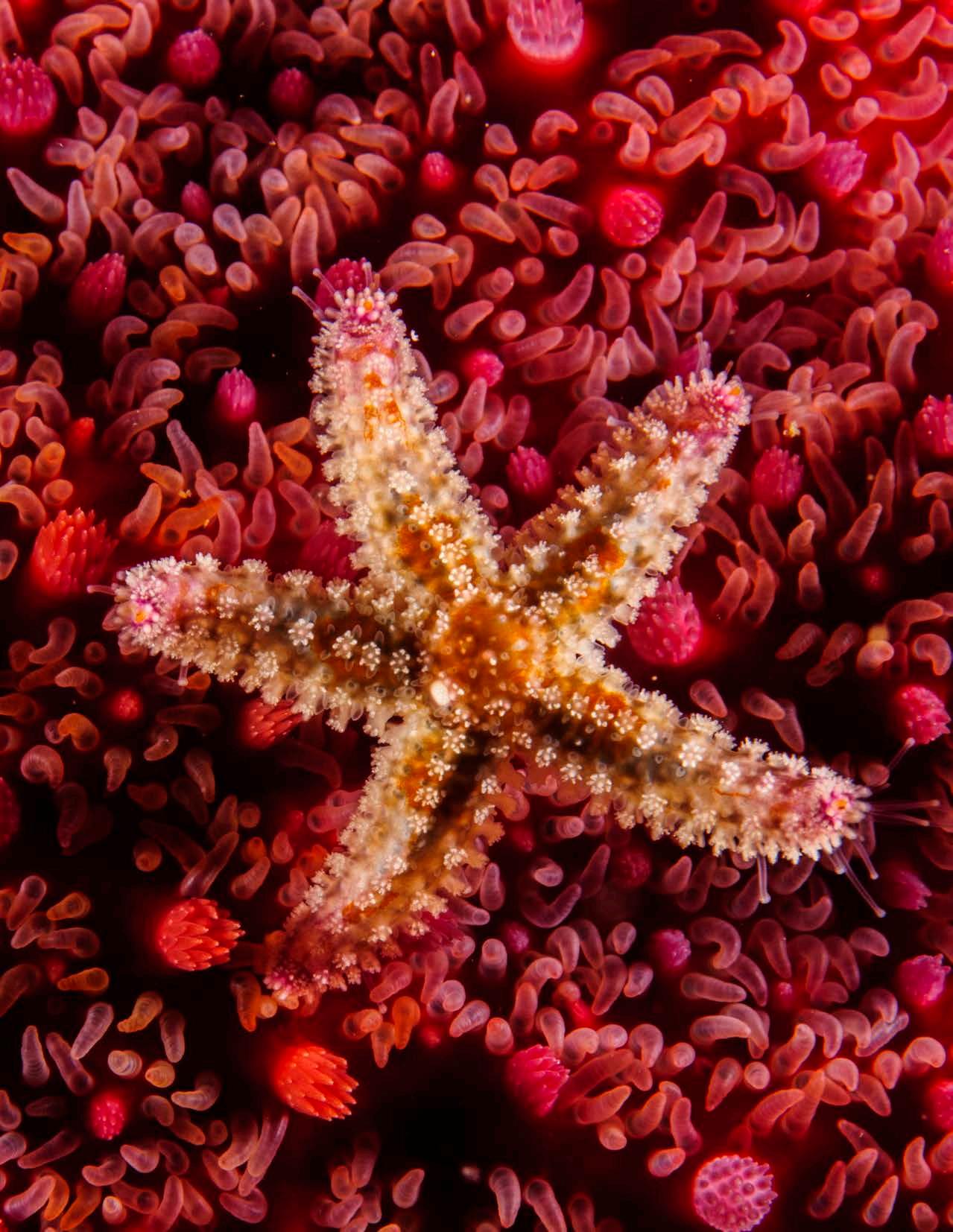
SUMMER 2018 | Oceana.org35
©Oceana/Juan Cuetos
Fin Win Mackerel makes a comeback
Mark Bittman is an award-winning food journalist, author and former columnist for the New York Times. He is a fellow at the Union of Concerned Scientists and a faculty member of Columbia University’s Mailman School of Public Health.

Mackerel is one of the loveliest fish there is, one of the tastiest, cheapest, most versatile, and most plentiful. And it’s scorned by nearly everyone, the symbol of stinkiness, a fish we think of as too strong-flavored, too oily and too fishy. But the reality is: Mackerel is fatty, rich-flavored, moist and so sweet that it is almost requisite to cook it with acidic flavorings such as soy or lemon.

There are many different mackerel: common (Atlantic) mackerel are usually no larger than two pounds, and may be sold whole or filleted; larger fish, such as Spanish mackerel, may be steaked or sold whole or filleted. Generally, mackerel is a dark, rich fish, with no scales and good-tasting skin; the bones
are easily removed, making mackerel the best fish on which to practice filleting.
Even more than most fish, mackerel is best eaten when it is super-fresh. It does not freeze well, and its quality deteriorates rapidly once the fish is out of water. The English realized this three hundred years ago, when they made an exception to their blue laws and allowed mackerel to be hawked in the streets of London on Sunday, implicitly acknowledging that the fish would be nearly worthless by Monday. Since the vivid colors of mackerel begin to fade after death, the freshest fish are bright and vivid. Mackerel on ice should appear to be almost alive; if they have a dull, dead look, you should turn your gaze elsewhere. The smell should be very fresh and clean.
I like to broil whole mackerel, or grill it (its high oil content keeps it moist and discourages sticking), or pan-roast it with just a little fat and a little liquid; fillets are terrific poached or broiled. I’ve made the following recipe all the time, too many times to count; in my opinion, it’s the best dark fleshed fish recipe there is.
36
©SharkPaeCNX/Shutterstock
Belize Barrier Reef
Mackerel fillet simmered in soy sauce
Makes: 4 servings | Time: 20 minutes
Sauce for rice and delicious fish in one pot, in 20 minutes, with seven ingredients? No problem.
½ cup high-quality soy sauce
½ cup water
½ cup dry sherry
2 tablespoons rice or white wine vinegar
5 or 6 thin slices peeled fresh ginger
3 or 4 cloves garlic, crushed
4 mackerel fillets, (about 1 pound total, skin on)
In a 12-inch skillet with a cover, mix together all the ingredients except the fish. Bring to a boil and simmer over medium heat for about 5 minutes, uncovered. Add the fish, skin side down, cover, and simmer until the fish is cooked through (the thinnest end of the smallest fillet should just flake when prodded with a fork or knife, and the fish should all be opaque), 7 to 10 minutes. To serve, spoon a fillet and some sauce onto a mound of white rice.
Most Canada- and U.S.-caught mackerel are a sustainable choice.

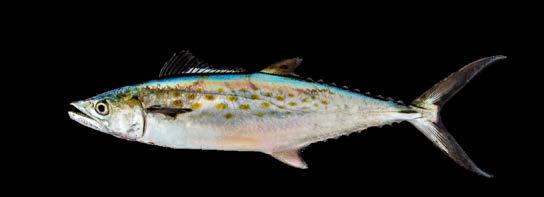
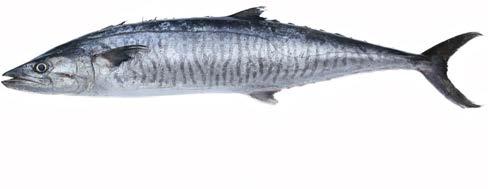
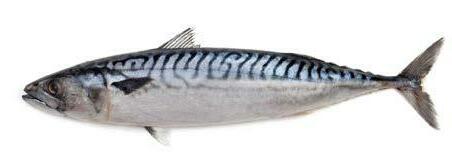
SUMMER 2018 | Oceana.org37
Atlantic Mackerel
Atlantic Spanish Mackerel
King Mackerel
©Shutterstock
Atka Mackerel
In June, the Belize Barrier Reef — the second largest barrier reef in the world — was removed from UNESCO’s “List of World Heritage in Danger,” where it has been listed since 2009. This beautiful but fragile reef had been threatened by overdevelopment, overfishing and the prospect of offshore oil.
The danger of an oil spill was averted late last year, when the government of Belize implemented a moratorium on offshore oil and gas development in all of Belize’s waters. The announcement was a major victory for Oceana, and the result of a massive, decade-long campaign against offshore oil that had mobilized the Belizean public, often in dramatic fashion.
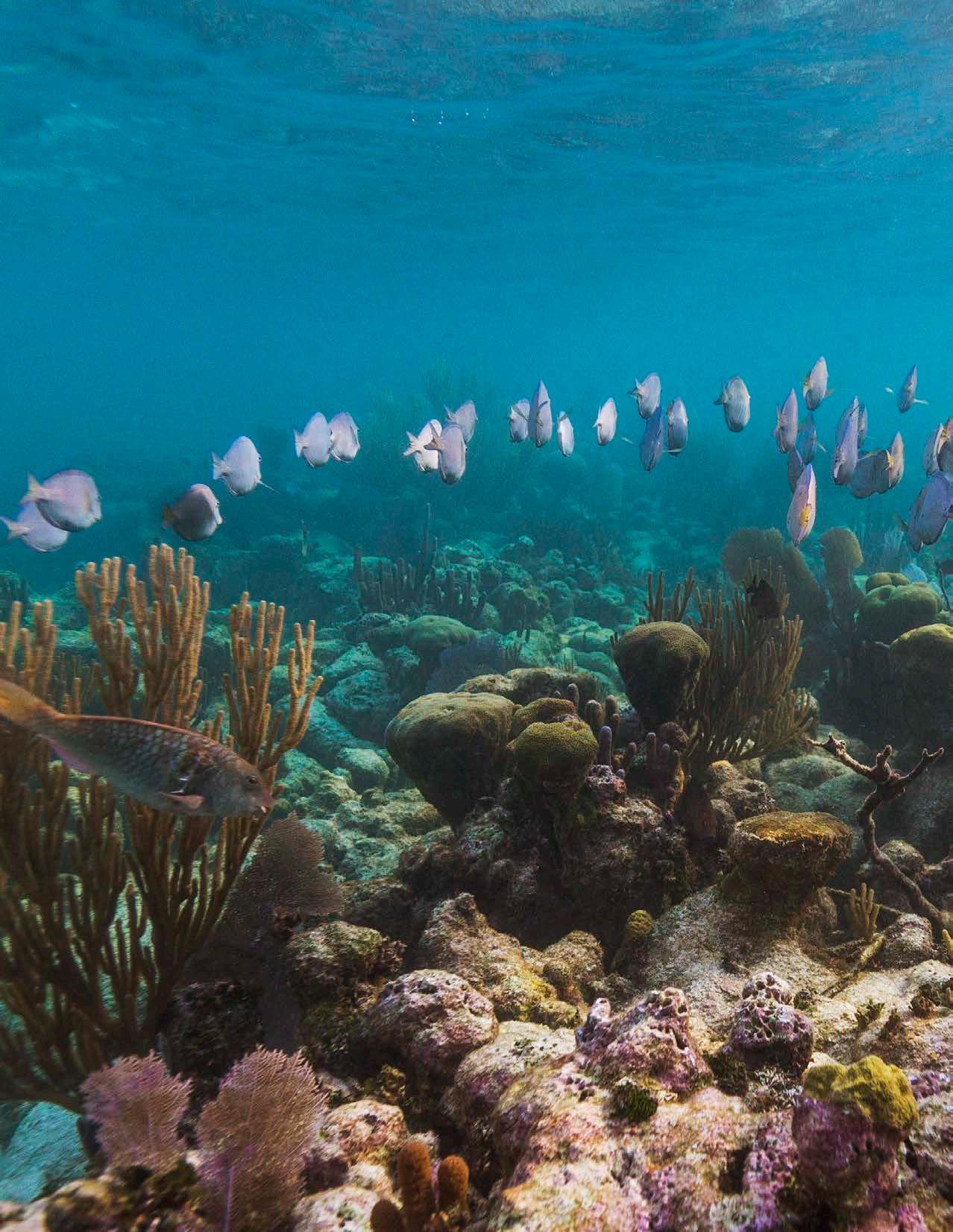
©Oceana/A Ellis 38
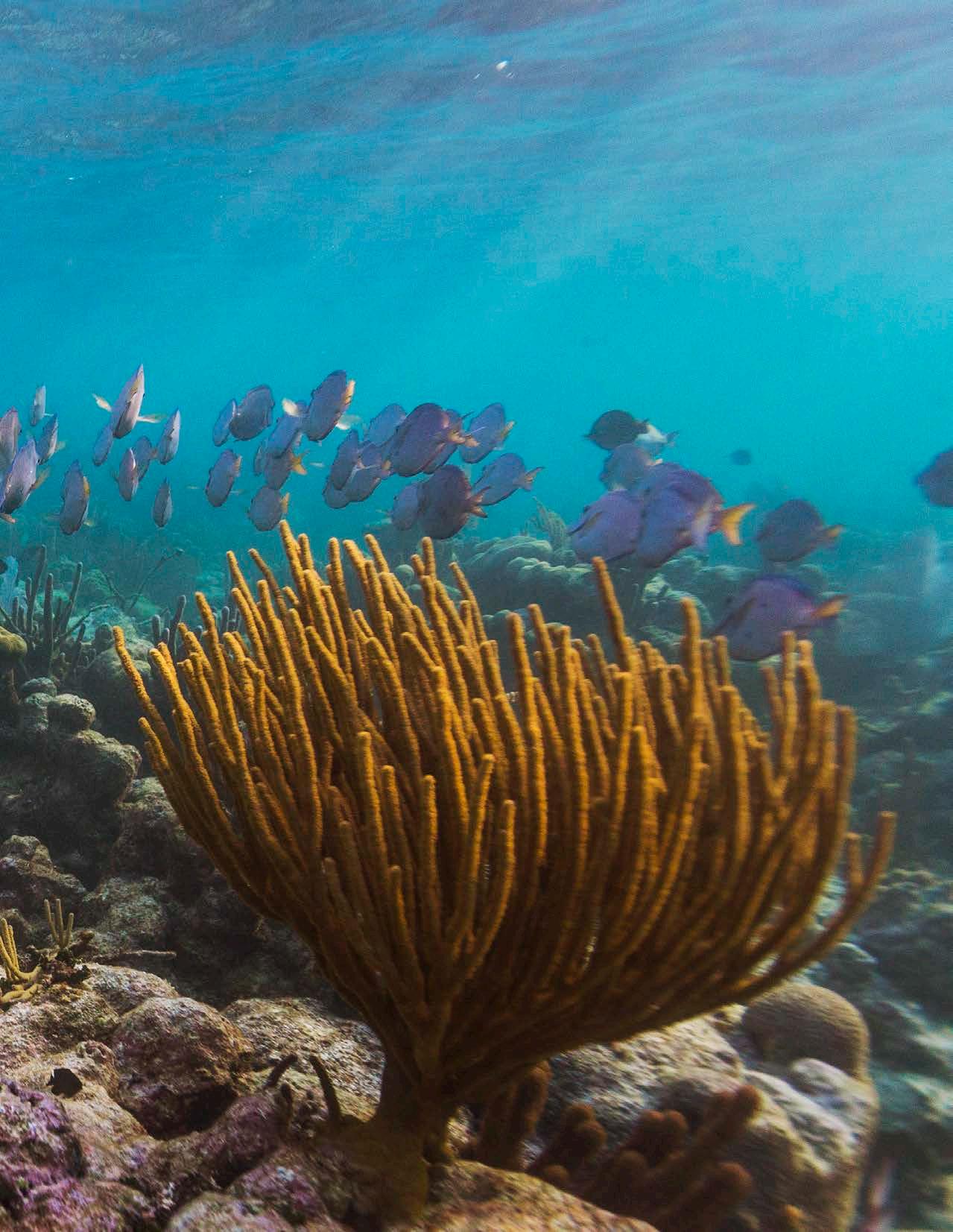
SUMMER 2018 | Oceana.org39
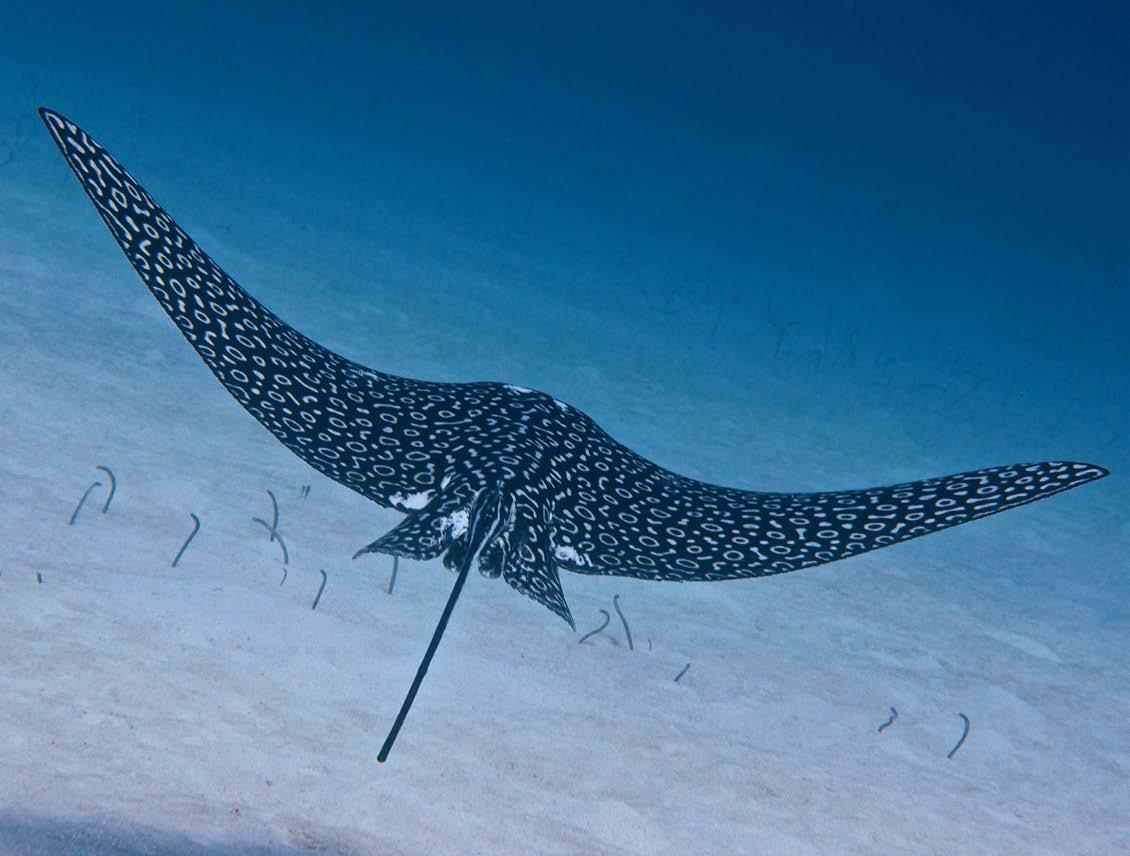
Global | Washington, D.C. Europe | Brussels | Copenhagen | Madrid | Geneva | London South America | Brasilia | Santiago | Lima Asia | Manila North America | Belmopan | Ft. Lauderdale | Juneau | Mexico City | Monterey | New York | Portland | Toronto Go to Oceana.org and give today. 1025 Connecticut Ave NW, Suite 200 Washington, DC 20036 USA phone: +1.202.833.3900 toll-free: 1.877.7.OCEANA You can help Oceana fight to restore our oceans with your financial contribution. Call us today at 1.877.7.OCEANA, go to our website www.oceana.org/give and click on “give today” or use the envelope provided in this newsletter. You can also invest in the future of our oceans by remembering Oceana in your will. Please contact us to find out how. All contributions to Oceana are tax deductible. Oceana is a 501(c)(3) organization as designated by the Internal Revenue Service.
accomplishments wouldn’t be possible without the support of its members.
Oceana’s
Spotted eagle rays are listed as “near threatened” by the International Union for the Conservation of Nature.
©Amanda Nicholls/Shutterstock

































 ©Oceana / Karl Hurwood
©Oceana / Karl Hurwood




 A Sarcophyton coral extends its polyps to feed.
©Oceana / Karl Hurwood
©Oceana / Karl Hurwood
A Sarcophyton coral extends its polyps to feed.
©Oceana / Karl Hurwood
©Oceana / Karl Hurwood






























